aoac-method verification
AOAC亚硫酸盐测定详细方法
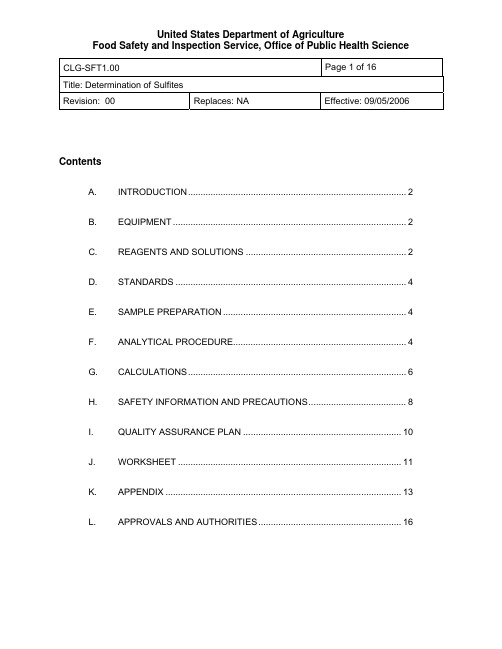
Title: Determination of SulfitesRevision: 00Replaces: NA Effective: 09/05/2006ContentsA.INTRODUCTION (2)B.EQUIPMENT (2)C.REAGENTS AND SOLUTIONS (2)D.STANDARDS (4)E.SAMPLE PREPARATION (4)F.ANALYTICAL PROCEDURE (4)G.CALCULATIONS (6)H.SAFETY INFORMATION AND PRECAUTIONS (8)I.QUALITY ASSURANCE PLAN (10)J.WORKSHEET (11)K.APPENDIX (13)L.APPROVALS AND AUTHORITIES (16)Title: Determination of SulfitesRevision: 00Replaces: NA Effective: 09/05/2006A. INTRODUCTION1. TheoryThis method measures free sulfite plus reproducible portion of bound sulfites, such ascarbonyl addition products, in meat products. A test portion is heated with refluxinghydrochloric acid to convert sulfite to sulfur dioxide (SO2) gas. A stream of nitrogenintroduced below the surface of the refluxing solution sweeps SO2 through a water-cooled condenser. SO2 is trapped by bubbling through a 3% hydrogen peroxidesolution, where it is oxidized to sulfuric acid. Sulfite content is directly proportional togenerated sulfuric acid, which is determined by titration with standardized sodiumhydroxide solution. For verification, sulfate is determined gravimetrically as bariumsulfate.2. ApplicabilityThis method is applicable to fresh and processed meat and poultry products at levels of ≥ 15 ppm. This method is applicable in the presence of other volatile sulfur compounds.It is not applicable to dried onions, leeks, and cabbage.B. EQUIPMENTNote: Equivalent equipment may be substituted for any of the following.1. Apparatusa. Distillation apparatus - Refer to Figures 1 and 2, section K.b. Burette - 10 mL, Cat. No. 17124-F, Kimble Glass, Inc.c. Flasks - Erlenmeyer, with screw caps or stoppers.d. Chilled water circulator - Chill condenser with coolant, such as methanol-water(20 + 40, v/v), maintained at <15 °C. Circulating pump, Neslab Coolflow 33.e. Micropipettors - (100 to 1000 µL), Cat. EP2500, Rainin.C. REAGENTS AND SOLUTIONSNote: Equivalent reagents and solutions may be substituted for any of the following.1. Reagentsa. Hydrochloric Acid (HCl) - 12N, reagent grade, Cat. No. JT9530, VWR.b. Hydrogen peroxide (H2O2) - 30% ACS reagent, Cat. No. JT2186, VWR.c. Diethyl Ether (C4H10O) anhydrous - Cat. No. JT9244, VWR.d. Ethanol (EtOH) absolute - Cat. No. MK618310, VWR.Title: Determination of SulfitesRevision: 00Replaces: NA Effective: 09/05/2006(N2) - High purity, Used with regulator to maintain flow of 200 mL/min.e. NitrogenNote: To guard against oxygen in N2 gas, use GC-type trap (Oxy-Purge NAlltech-Applied Science Laboratories, Inc.).Also, an indicating oxygen trap Phenomenex P/N AGO 4776 can be used toindicate when to change the trap.f. Barium Chloride (BaCl2) reagent grade - Cat. No. MK375602, VWR.g. 0.010N Sodium Hydroxide (NaOH) Solution - Cat. No. JT5663, VWR.h. Water - deionized (18 megohm), prepared from distilled water.Note: Optional - Water - deionized, deoxygenated. Sparge ~4L deionized waterwith an inert gas (N2, He) at 250-300 mL/minute for at least 15 minutes. Store inairtight container.i. Sodium Hydroxymethylsulfonate (HMS) - Cat. No. 112704, Aldrich Chemical Co.j. Sodium monohydrogen phosphate heptahydrate (Na2HPO4•7H2O) - Cat No.MK791404, VWR.(C6H14O6) - Cat. No. M-9546, Sigma.k. D-mannitoll. Methyl red - Cat. No. 25,019-8, Aldrich Chemical Co.2. Solutionsa. 4N HCl :Add 30 mL of 12N HCl to 60 mL deionized water and carefully mix.b. Methyl red indicator:Dissolve 250 mg methyl red in 100 mL ethanol.c. Standardized titrant (0.010N NaOH):Certified reagent may be used. Alternatively, prepare from a 1N NaOH solution(4.0 g NaOH diluted to 100 mL with distilled water) by diluting 1:100 with distilledwater. Standardize solution with reference standard potassium acid phthalate, to3 significant figures (nearest 0.0001N). Store titrant tightly sealed in suitableplastic container.d. 3% Hydrogen peroxide solution:For each analysis, dilute 3 mL 30% H2O2 to 30 mL with deionized water. Justprior to use, add 3 - 5 drops methyl red indicator and titrate with 0.01N NaOH justto a yellow end point. If end point is exceeded, discard solution.e. 10% Barium Chloride:Dilute 5.0 g BaCl2 to 50 mL with deionized water.f. HMS Diluent (0.04M Na2HPO4·7H2O + 0.10M d-mannitol):Title: Determination of SulfitesRevision: 00Replaces: NA Effective: 09/05/2006 Weigh 10.7 g Na2HPO4•7H2O + 18.2 g d-mannitol into a 1L volumetric flask.Dissolve and dilute to volume with deionized water. Store in refrigerator. Stablefor 1 year.HCl:g. 1NAdd 1 volume 12N HCl to 11 volumes deionized water and mix.D. STANDARDS1. Potassium acid phthalate (If required for standardization of NaOH titrant), Cat. No.P1190, Spectrum.2. Sodium hydroxymethylsulfonate (HMS) - ~95% purity, Cat. No. 11,270-4, Aldrich.3. HMS fortification solution (5 µg/µL as SO2):Weigh approximately 110 mg HMS into small beaker. Dissolve in HMS diluent (C.2.f)and quantitatively transfer to a 10 mL volumetric flask. Dilute to volume with HMSdiluent. Calculate equivalent SO2 concentration using the formula:Conc. SO2, µg/µL = (g HMS weighed x 0.4778) x (%Purity HMS) /1000[Example: SO2, µg/µL = 110.0 x 0.4778 x 95 /1000 = 4.99 (5.0)]Note: On the basis of a 50 g sample weight, each 10 µL of this solution added equalsapproximately 1 ppm SO2 added to the recovery.PREPARATIONE. SAMPLESamples should be cold when received and stored cold (preferably frozen) in airtightcontainers to minimize degradation of labile sulfites. If samples are ground prior toanalysis, care should be taken to minimize exposure to air and heat.PROCEDUREF. ANALYTICALCaution: Carry out test sample preparation and analysis as quickly as possible to avoid loss of labile forms of sulfite.Refer to section I.6 for information regarding controls that must be included as part ofevery sample set.1. Weigh approximately 50 g product, or quantity that contains 500 - 1500 µg SO2, tonearest 0.1 g, into three-neck round bottom distillation flask.Note: A recovery should be prepared at this time by fortifying blank tissue with anappropriate amount of HMS solution (D.3). If SO2 content of the blank tissue has notbeen previously determined, it must be analyzed as part of the set.Note: Titration and gravimetric readings from a tissue blank may be used in place ofTitle: Determination of SulfitesRevision: 00Replaces: NA Effective: 09/05/2006 those from a reagent blank, in calculations described in section G parts 2 and 3, if thetissue blank is known to contain <1 ppm SO2, using gravimetric quantitation.2. Add 400 - 500 mL H2O to flask, taking care to rinse down any residual sample that maycling to the neck or walls of the flask. Dry neck of flask with tissue. Proceedimmediately to next step.3. Assemble apparatus described in B.1.a (refer to Figure 1, Section K). Apply stopcockgrease or Teflon® sleeves to all joints and clamp where practical.Note: Most assembly may take place prior to start of analysis in order to save time.Order of steps a-c below is not critical.a. Place flask (C), containing sample, into heating mantle controlled by power-regulating device (rheostat).b. Close stopcock of separatory funnel (B) and add 90 mL 4N HCl to funnel.c. Add 30 mL 3% H2O2, which has been titrated to yellow end point with 0.01NNaOH, to vessel (G).d. Before putting vessel (G) into place, adjust nitrogen flow to 190 - 210 mL/minusing a flowmeter. Count bubble rate in flask (C). After attaching vessel (G),readjust nitrogen flow, if necessary to maintain the same bubble rate in flask.4. Purge apparatus and check for leaksa. Initiate condenser coolant flow at this time. Allow 15 min for N2 flow to purgesystem of oxygen.b. Inspect system to verify that all joints are leak free.5. Generate and distill SO2a. Apply positive pressure to separatory funnel using a rubber bulb or otherapparatus. Open stopcock and let HCl flow into flask. Maintain sufficientpressure to force acid solution into flask without allowing gases from flask tobubble into funnel. Stopcock may be closed, if necessary, to pump up pressureabove acid, and then opened again.b. Close stopcock before last 2 - 3 mL drain out of separatory funnel to guardagainst escape of SO2 into separatory funnel.c. Apply power to the heating mantle, using a power setting that causes 80 - 90drops/min of condensate to return to flask from condenser.d. Let contents of flask boil 1 hour 45 minutes, then remove vessel (G) and turn offpower to mantle.e. Quantitatively transfer contents of vessel to a 125 mL Erlenmeyer flask using asmall volume of deionized water. Note: Solution is stable for several hours whenTitle: Determination of SulfitesRevision: 00Replaces: NA Effective: 09/05/2006 flask is capped, but following step must be done on day of distillation.H2SO4 from vessel G.6. TitrateTitrate contents of Erlenmeyer flask with 0.010N NaOH to yellow end point that persists at least 20 seconds.7. Gravimetric determination (Required if titration indicates reportable amounts of SO2detected).a. Add 4 drops 1N HCl and an excess of filtered 10% BaCl2 solution to flask, and letmixture stand overnight.b. Swirl flask contents to suspend precipitate and pour through a tared Goochcrucible. Quantitatively transfer residual precipitate in flask using threeapproximately 20 mL portions of hot water, and allow to drain. Wash crucible with20 mL absolute alcohol and 20 mL ether, and dry for at least 2 hours at105 - 110 °C.c. Allow crucible to cool, then reweigh. Calculate weight of BaSO4 in milligrams bysubtracting the tare.G. CALCULATIONS1. A reagent blank must be run and calculated for both titration (as mL NaOH) andgravimetric quantitation (as mg BaSO4) for each sample set.2. Titration Quantitation: Compute sulfite content, expressed in µg SO2/g food (ppm), asfollows:SO2 (ppm) = (32.03)(V Corr )(N)(1000) / W Sample, Where32.03 = milliequivalent weight of SO2N = Normality of NaOH titrant.V Corr = volume (mL) of NaOH of normality N required to reach end point, minusthe NaOH volume required to titrate the reagent blank.1000 = factor to convert milliequivalents to microequivalents.W Sample = Sample weight, in grams.3. Gravimetric Quantitation: Compute sulfite content, expressed in µg SO2/g food (ppm), asfollows:SO2 (ppm) = (mg BaSO4 Sample - mg BaSO4 Blank)(274.46) / W Sample Wheremg BaSO4 Sample and mg BaSO4 Blank are the weights of BaSO4 precipitatesrecorded for the sample and reagent blank, respectively.274.46 = Conversion factor: (1000) (FW SO2) / FW BaSO4 (FW = formula wt.)W Sample = Sample weight, in grams.Title: Determination of SulfitesRevision: 00Replaces: NA Effective: 09/05/2006Calculation:4. Recoverya. Determine the SO2 concentration in the recovery (SO2 found). Correct for tissueblank.b. Determine recovery’s fortified level (SO2 added) usingSO2 added, (ppm) = (C Fort)(V Fort) / W SampleWhere:C Fort = Concentration of fortification Solution (D.3) in µg SO2 /µLV Fort = Volume of fortification solution added, in µL.W Sample = Sample weight, in grams.c. Calculate % Recovery as:% Recovery = 100% × (SO2 found / SO2 added).Title: Determination of SulfitesRevision: 00Replaces: NA Effective: 09/05/2006H. SAFETY INFORMATION AND PRECAUTIONS1. Required Protective Equipment - Lab coat, safety glasses, plastic gloves, thermalgloves.2. HazardsReagent or Action Hazard Recommended Safe Procedures Hydrogen Peroxide Corrosive to skin. Avoid contact with skin.Hydrochloric Acid, Sodium Hydroxide Irritating to mucusmembranes, corrosive to skinAvoid breathing vapors. Avoidcontact with skin.Diethyl Ether Highly flammable. Explosivehazard, vapors, mixed with air,will explode if ignited.Inhalation of highconcentration will causenarcosis, unconsciousness. Keep tightly closed and away from fire. Use under fume hood. Avoid breathing vapor.Ethanol Flammable Keep tightly closed and awayfrom fire.Barium Chloride May cause skin irritation. Maycause eye irritation. May beharmful if absorbed throughthe skin. Harmful if inhaled.Material may be irritating tomucous membranes andupper respiratory tract. Toxicif swallowed. Keep tightly closed. Do not breathe dust. Do not get in eyes, on skin, on clothing. Avoid prolonged or repeated exposure.3. DisposalProceduresProcedure Step Hazard Recommended Safe ProceduresDiethyl Ether See Above Dispose according to appropriatelocal, state and federalregulationsEthanol See Above Dispose according to appropriatelocal, state and federalregulationsTitle: Determination of SulfitesRevision: 00Replaces: NA Effective: 09/05/2006 Diethyl Ether See Above Dispose according to appropriatelocal, state and federalregulationsBarium Sulfate See Above Dispose according to appropriatelocal, state and federalregulationsHydrochloric Acid See Above Dispose according to appropriatelocal, state and federalregulations.May be neutralized and disposedthrough the sanitary sewersystem.Sodium Hydroxide See Above May be neutralized and disposedthrough the sanitary sewersystem. Dispose according toappropriate local, state andfederal regulations Hydrogen Peroxide See Above Dispose according to appropriatelocal, state and federalregulationsTitle: Determination of SulfitesRevision: 00Replaces: NA Effective: 09/05/2006I. QUALITY ASSURANCE PLAN1. PerformanceStandardAnalyte Analytical Range Acceptable Recovery,Titrimetric AnalysisAcceptable RecoveryGravimetric Analysis)Sulfite ≥15 ppm 60 - 95% 60 -105%2. Critical Control Points and SpecificationsRecord Acceptable Controla. Sample weight Amount to contain 500 - 1500 µg SO2b. Apparatus integrity Verify apparatus is completely sealedc. Distillation Rate Adjust to 80 - 90 drops per minuted. Distillation Time 1 hour 45 minutese. Titration End point must persist at least 20 seconds3. Readiness To Perform (FSIS Training Plan)Before beginning familiarization exercises listed below, trainee should read andunderstand method and observe experienced analyst, if possible.a. Familiarizationi. Phase I: N/Aii. Phase II: Analysis of fortified samples - Minimum of 3 replicates fortified at 15 - 100 ppm over a period of 3 different days (9 samples total).iii. Phase III: Check samples, analytes concentrations unknown to theanalyst.(a) Minimum 6 recoveries fortified at 15 - 100 ppm levels.(b) Report analytical findings to Supervisor/Quality Manager (QAM)(c) Letter from QAM is required to commence official analysis.b. Acceptabilitycriteria.Refer to section I.1 above.4. Intralaboratory Check Samplesa. System,minimumcontents.United States Department of AgricultureFood Safety and Inspection Service, Office of Public Health Science CLG-SFT1.00Page 11 of 16Title: Determination of SulfitesRevision: 00Replaces: NA Effective: 09/05/2006i. Frequency: One per week per analyst when samples analyzed.ii. Records are to be maintained.criteria.b. AcceptabilityRefer to section I. 1.If unacceptable values are obtained, then:i. Stop official analyses by that analyst.ii. Take corrective action.5. Sample Acceptability and Stabilitya. Matrix: Fresh and processed meat and poultry products.b. Minimum Sample Size: 500 g.c. Condition upon receipt: Sealed from air, and unspoiled.d. Samplestorage:i. Time: Stability unknown, likely to vary with sample type and condition.Samples should be analyzed as soon as possible.ii. Condition: Frozen and stored in airtight container.Set6. Samplea. Reagent blank and/or tissue blank (see section F.1.)b. Recovery (fortified blank tissue) must be included in each sample set. If thetissue used to prepare the recovery has not been previously analyzed, it mustalso be included in the sample set.c. Test samples to be analyzed.7. SensitivityMinimum proficiency level (MPL): 15 ppm.J. WORKSHEETThe following is an example of a worksheet.Title: Determination of SulfitesRevision: 00Replaces: NA Effective: 09/05/2006Analyst: DateStarted: DateCompleted:Fortification Std. ILN: HOCH2SO3Na%Purity:CrucibleBalance #: Oven:STDBalance: 30%H2O2 #: 1N HCl #: Time In:Weight (g): Methyl Red #: 10% BaCl2: Temp0C: µL Fortified: NAOH #: EtOH: Time Out:ppm: NAOH(N): EthylEther: Temp0C:SampleBalance #: 4N HCl #: Crucible-ReweighBalance #:Thermometer#:Buffer #: Standardization book #:Sol'n Book#:Pipette #: Volumetric NaOH TitrationSample Serial # Weight (g) Start ml End ml Total ml ppm SO2% RecTissueBlankRec.# %GravimetricSample Crucible # Crucible wt (g) Total wt(g)Sample(mg): ppm SO2% RecTissue BlankRec.# %Title: Determination of SulfitesRevision: 00Replaces: NA Effective: 09/05/2006K. APPENDIX1. Referencesa. AOAC Official Method 990.28.b. “Optimized Monier-Williams Method for Determination of Sulfites in Foods:Collaborative Study” (1989), J. Assoc. Off. Anal. Chem. 72, 470-475.2. Figure 1. Monier Williams SO2 Distillation Apparatus.Figure 2. Bubbler.Title: Determination of SulfitesRevision: 00Replaces: NA Effective: 09/05/2006 Figure 1.(A) Inlet adapter with hose connector (Kontes 183000);(B) Separatory funnel, ≥100 mL capacity;(C) Round-bottom flask, 1 L, with three 24/40 tapered joints;(D) Gas inlet tube (Kontes 179000) of sufficient length to permit introduction of N2within 2.5 cm of bottom of flask;(E) Allihn condenser, (Kontes 431000-2430), jacket length 300 mm.(F) Bubbler, fabricated from glass according to dimensions in Figure 2;(G) Receiving vessel, ca 2.5 cm id and 18 cm deep.Title: Determination of SulfitesRevision: 00Replaces: NA Effective: 09/05/2006 Figure 2. (See K.2. Figure 1.F)Title: Determination of SulfitesRevision: 00Replaces: NA Effective: 09/05/2006AUTHORITIESANDL. APPROVALSApprovals on file.Issuing Authority: Laboratory Quality Assurance Division.。
AOAC990.28 Sulfites in Foods 食品中亚硫酸盐的检测方法
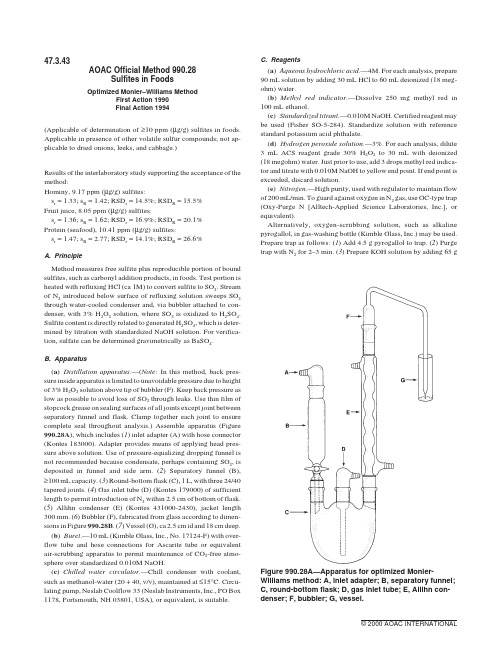
47.3.43AOAC Official Method990.28Sulfites in FoodsOptimized Monier–Williams MethodFirst Action1990Final Action1994(Applicable of determination of≥10ppm(µg/g)sulfites in foods. Applicable in presence of other volatile sulfur compounds;not ap-plicable to dried onions,leeks,and cabbage.)Results of the interlaboratory study supporting the acceptance of the method:Hominy,9.17ppm(µg/g)sulfites:s r=1.33;s R=1.42;RSD r=14.5%;RSD R=15.5%Fruit juice,8.05ppm(µg/g)sulfites:s r=1.36;s R=1.62;RSD r=16.9%;RSD R=20.1%Protein(seafood),10.41ppm(µg/g)sulfites:s r=1.47;s R=2.77;RSD r=14.1%;RSD R=26.6%A.PrincipleMethod measures free sulfite plus reproducible portion of bound sulfites,such as carbonyl addition products,in foods.Test portion is heated with refluxing HCl(ca1M)to convert sulfite to SO2.Stream of N2introduced below surface of refluxing solution sweeps SO2 through water-cooled condenser and,via bubbler attached to con-denser,with3%H2O2solution,where SO2is oxidized to H2SO4. Sulfite content is directly related to generated H2SO4,which is deter-mined by titration with standardized NaOH solution.For verifica-tion,sulfate can be determined gravimetrically as BaSO4.B.Apparatus(a)Distillation apparatus.—(Note:In this method,back pres-sure inside apparatus is limited to unavoidable pressure due to height of3%H2O2solution above tip of bubbler(F).Keep back pressure as low as possible to avoid loss of SO2through e thin film of stopcock grease on sealing surfaces of all joints except joint between separatory funnel and flask.Clamp together each joint to ensure complete seal throughout analysis.)Assemble apparatus(Figure 990.28A),which includes(1)inlet adapter(A)with hose connector (Kontes183000).Adapter provides means of applying head pres-sure above e of pressure-equalizing dropping funnel is not recommended because condensate,perhaps containing SO2,is deposited in funnel and side arm.(2)Separatory funnel(B),≥100mL capacity.(3)Round-bottom flask(C),1L,with three24/40 tapered joints.(4)Gas inlet tube(D)(Kontes179000)of sufficient length to permit introduction of N2within2.5cm of bottom of flask.(5)Allihn condenser(E)(Kontes431000-2430),jacket length 300mm.(6)Bubbler(F),fabricated from glass according to dimen-sions in Figure990.28B.(7)Vessel(G),ca2.5cm id and18cm deep.(b)Buret.—10mL(Kimble Glass,Inc.,No.17124-F)with over-flow tube and hose connections for Ascarite tube or equivalent air-scrubbing apparatus to permit maintenance of CO2-free atmo-sphere over standardized0.010M NaOH.(c)Chilled water circulator.—Chill condenser with coolant, such as methanol-water(20+40,v/v),maintained at≤15°C.Circu-lating pump,Neslab Coolflow33(Neslab Instruments,Inc.,PO Box 1178,Portsmouth,NH03801,USA),or equivalent,is suitable.C.Reagents(a)Aqueous hydrochloric acid.—4M.For each analysis,prepare 90mL solution by adding30mL HCl to60mL deionized(18meg-ohm)water.(b)Methyl red indicator.—Dissolve250mg methyl red in 100mL ethanol.(c)Standardized titrant.—0.010M NaOH.Certified reagent may be used(Fisher SO-5-284).Standardize solution with reference standard potassium acid phthalate.(d)Hydrogen peroxide solution.—3%.For each analysis,dilute 3mL ACS reagent grade30%H2O2to30mL with deionized (18megohm)water.Just prior to use,add3drops methyl red indica-tor and titrate with0.010M NaOH to yellow end point.If end point is exceeded,discard solution.(e)Nitrogen.—High purity,used with regulator to maintain flow of200mL/min.To guard against oxygen in N2gas,use GC-type trap (Oxy-Purge N[Alltech-Applied Science Laboratories,Inc.],or equivalent).Alternatively,oxygen-scrubbing solution,such as alkaline pyrogallol,in gas-washing bottle(Kimble Glass,Inc.)may be used. Prepare trap as follows:(1)Add4.5g pyrogallol to trap.(2)Purge trap with N2for2–3min.(3)Prepare KOH solution by adding65gFigure990.28A—Apparatus for optimized Monier-Williams method:A,inlet adapter;B,separatory funnel; C,round-bottom flask;D,gas inlet tube;E,Allihn con-denser;F,bubbler;G,vessel.KOH to85mL H2O.(Caution:Heat is generated.)(4)Add KOH so-lution to trap while atmosphere of N2is maintained in trap.D.Test Sample Preparation(a)Solids.—Transfer50g food,or quantity that contains 500–1500µg SO2,to food processor or blender.Add100mL etha-nol–water(5+95,v/v)and briefly grind mixture.Continue grinding or blending only until food is chopped into pieces small enough to pass through standard taper24/40joint of flask(C).(b)Liquids.—Mix50g test portion,or quantity that contains 500–1500µg SO2with100mL ethanol-water(5+95,v/v). (Note:Carry out test sample preparation and analysis as quickly as possible to avoid loss of labile forms of sulfite.)E.System PreparationUsing apparatus assembled as shown in Figure990.28A,position flask(C)in heating mantle controlled by power-regulating device (rheostat),and add400mL H2O to flask.Close stopcock of separa-tory funnel(B)and add90mL4M HCl to separatory funnel.Begin N2flow at200±10mL/min.Initiate condenser coolant flow at this time.To vessel(G)add30mL3%H2O2,which has been titrated to yellow end point with0.010M NaOH.After15min,apparatus and water will be thoroughly deoxygenated and prepared test portion may be introduced into system.F.Sample Introduction and DistillationRemove separatory funnel(B)and quantitatively transfer test por-tion in aqueous ethanol to flask(C).Wipe tapered joint clean with laboratory tissue,quickly apply stopcock grease to outer joint of separatory funnel,and return separatory funnel to flask.Nitrogen flow through3%H2O2solution resumes as soon as separatory funnel is reinserted into appropriate joint in flask.Examine each joint to be sure that it is sealed.Use rubber bulb equipped with valve to apply head pressure above HCl in separatory funnel.Open stopcock in separatory funnel and let HCl flow into flask.Continue to maintain sufficient pressure above acid solution to force solution into flask.Stopcock may be closed,if necessary,to pump up pressure above acid,and then opened again. Close stopcock before last2–3mL drain out of separatory funnel to guard against escape of SO2into separatory funnel.Apply power to heating e power setting that causes 80–90drops/min of condensate to return to flask from condenser. Let contents of flask boil1.7h,and then remove vessel(G).G.Determination(a)Titration.—Immediately titrate contents of vessel(G)with0.010M NaOH to yellow end point that persists≥pute sul-fite content,expressed inµg SO2/g food(ppm),as follows:SO2,µg/g(ppm)=32031000.×××V MweightBwhere32.03=milliequivalent weight of SO2;V B=volume(mL)of NaOH of molarity M required to reach end point;1000=factor to convert milliequivalents to microequivalents;weight=weight,g,of test portion introduced into1L flask.(b)Gravimetric determination.—Optional.Following titration, rinse contents of vessel(G)into400mL beaker.Add4drops1M HCl and excess of filtered10%BaCl2solution,and let mixture stand overnight.Wash precipitate by decantation3times with hot water through weighed Gooch crucible.Wash with20mL alcohol and 20mL ether,and dry at105–110°C.SO2,µg/g(ppm)=mg BaSOg test portion4×27446.(c)Blank determination.—Determine blank on reagents both by titration and gravimetrically,and correct results accordingly.H.Recovery AssaysTo become familiar and proficient with method before routine use,analyze food test portions containing known amounts of sulfite. Perform analysis in manner that precludes any loss of sulfite by oxi-dation or reaction with components in food.Since sulfites are reac-tive with air and food matrixes and lack stability,fortify portions with stable source of sulfite,not sodium sulfite or similar salts.So-dium hydroxymethylsulfonate(HMS),which is bisulfite addition product of formaldehyde and is structurally similar to some com-bined forms of sulfite in foods,is useful for preparing stable fortified test materials.For analysis,transfer50g prepared test sample of sulfite-free food to Monier-Williams flask.Add aliquot of aqueous solution of HMS sodium salt.Analyze solution immediately.HMS recoveries of≥80%from food matrixes fortified at10µg/g are recommended to ensure accurate analytical data. Reference:JAOAC72,470(1989).CAS-7446-09-5(sulfur dioxide)Figure990.28B—Enlarged diagram of bubbler for Monier-Williams apparatus(lengths in mm).。
化学分析方法确认指南(翻译)

化学分析方法确认指南(翻译)2.对已确认方法的验收(Verification for previously validated methods)对于像ASTM,US EPA,ISO和IP这些已通过合作研究(collaborative studies)进行确认的方法,且能够适用于方法所要求的范围之内,对于这类的方法则不需要向内部方法(in-house method)那样的严格验证,同样适用于出版的带有实验数据的科学文献。
鉴于此,对于使用这些方法的实验室,大体上能够验证(verify)操作者按照方法中要求操作且能够获得相同的结果即可。
方法的验收(verification of method)必须包括对现有已验证方法使用前所进行统计纠正(statistical correlation)。
但需要注意的是,由于不同标准机构或公认的技术组织对于方法标准的文件化(documentation)差异,如果组织在所发布的方法中没有验证报告或缺乏部分性能(performance characteristics)或仅对部分性能确认(verify),则实验室不能够直接使用方法,需要确认。
在使用条件下的方法验收不仅仅是要验收体系符合于方法的要求,同样也验收了方法准确度、精确度或其它参数的符合性。
常用以下方式证明方法性能(method performance):l 空白,评定污染l 实验控制样品(e.g.化学分析加标),评定准确性l 重复测定,评定精确度l 定量的、批次的分析,需要定期验证校准曲线标准溶液l 监控质量控制样品,常通过使用控制表(SPC)l 参与能力验证,这些组织可提供与方法要求一致的样品,具有选择代表性的浓度值、基体、分析参数等。
如对原内部方法(in-house method)做了微小的改变(换成不同生产商生产的色谱柱,选择不同的生长基质等),则也需要对方法做验收。
验收程序中关键参数依赖于方法的性质和所可能遇到样品的类型。
实验室方法确认的31个概念
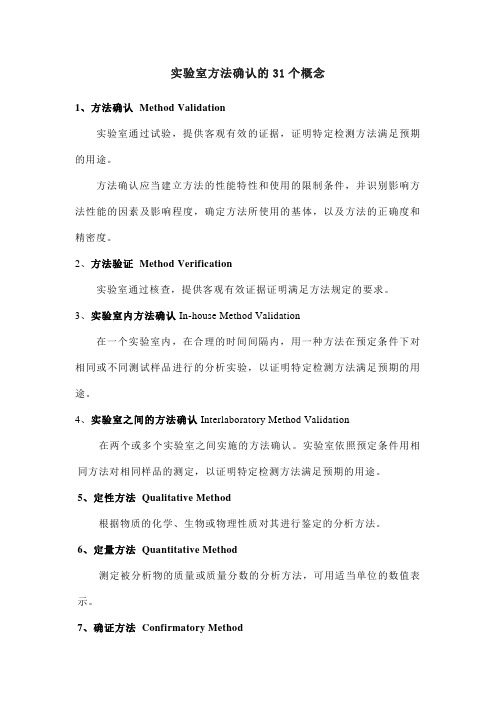
实验室方法确认的31个概念1、方法确认Method Validation实验室通过试验,提供客观有效的证据,证明特定检测方法满足预期的用途。
方法确认应当建立方法的性能特性和使用的限制条件,并识别影响方法性能的因素及影响程度,确定方法所使用的基体,以及方法的正确度和精密度。
2、方法验证Method Verification实验室通过核查,提供客观有效证据证明满足方法规定的要求。
3、实验室内方法确认In-house Method Validation在一个实验室内,在合理的时间间隔内,用一种方法在预定条件下对相同或不同测试样品进行的分析实验,以证明特定检测方法满足预期的用途。
4、实验室之间的方法确认Interlaboratory Method Validation在两个或多个实验室之间实施的方法确认。
实验室依照预定条件用相同方法对相同样品的测定,以证明特定检测方法满足预期的用途。
5、定性方法Qualitative Method根据物质的化学、生物或物理性质对其进行鉴定的分析方法。
6、定量方法Quantitative Method测定被分析物的质量或质量分数的分析方法,可用适当单位的数值表示。
7、确证方法Confirmatory Method能提供全部或部分信息,并明确定性,在必要时可在关注的浓度水平上进行定量的方法。
8、筛选方法Screening Method具有处理大量样品的能力,用于检测一种物质或一组物质在所关注的浓度水平上是否存在的方法。
这些方法用于筛选大量样品可能的阳性结果,并用来避免假阴性结果。
此类方法所获得的检测结果通常为定性结果或半定量结果。
9、容许限Permitted Limit, PL对某一定量特性规定和要求的物质限值,如:最大残留限、最高允许浓度或其他最大容许量等。
10、关注浓度水平Level of Interest对判断样品中物质或分析物是否符合法规规定和要求的有决定性意义的浓度(如:容许限浓度)。
美国Pickering柱后衍生仪-麻痹贝类毒素检测AOAC方法
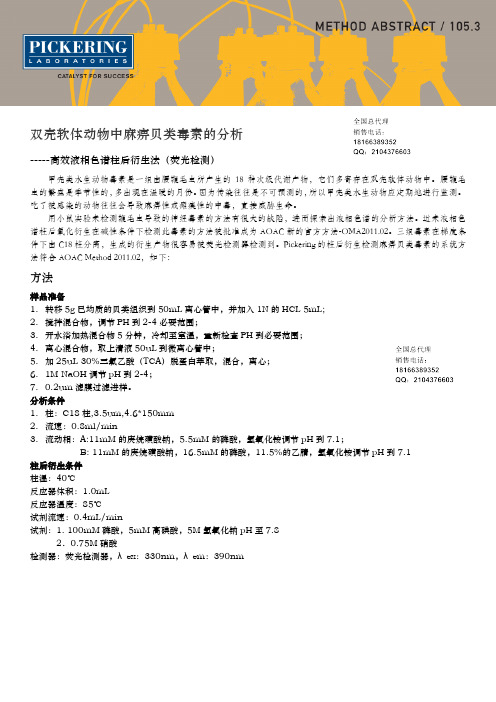
双壳软体动物中麻痹贝类毒素的分析-----高效液相色谱柱后衍生法(荧光检测)甲壳类水生动物毒素是一组由腰鞭毛虫所产生的18种次级代谢产物,它们多寄存在双壳软体动物中。
腰鞭毛虫的繁盛是季节性的,多出现在温暖的月份。
因为传染往往是不可预测的,所以甲壳类水生动物应定期地进行监测。
吃了被感染的动物往往会导致麻痹性或瘫痪性的中毒,直接威胁生命。
用小鼠实验来检测鞭毛虫导致的神经毒素的方法有很大的缺陷,进而探索出液相色谱的分析方法。
近来液相色谱柱后氧化衍生在碱性条件下检测此毒素的方法被批准成为AOAC新的官方方法-OMA2011.02。
三组毒素在梯度条件下由C18柱分离,生成的衍生产物很容易被荧光检测器检测到。
Pickering的柱后衍生检测麻痹贝类毒素的系统方法符合AOAC Method 2011.02,如下:方法样品准备1.转移5g已均质的贝类组织到50mL离心管中,并加入1N的HCL 5mL;2.搅拌混合物,调节PH到2-4必要范围;3.开水浴加热混合物5分钟,冷却至室温,重新检查PH到必要范围;4.离心混合物,取上清液50uL到微离心管中;5.加25uL 30%三氯乙酸(TCA)脱蛋白萃取,混合,离心;6.1M NaOH调节pH到2-4;7.0.2um滤膜过滤进样。
分析条件1.柱:C18柱,3.5um,4.6*150mm2.流速:0.8ml/min3.流动相:A:11mM的庚烷磺酸钠,5.5mM的磷酸,氢氧化铵调节pH到7.1;B: 11mM的庚烷磺酸钠,16.5mM的磷酸,11.5%的乙腈,氢氧化铵调节pH到7.1柱后衍生条件柱温:40℃反应器体积:1.0mL反应器温度:85℃试剂流速:0.4mL/min试剂:1. 100mM磷酸,5mM高碘酸,5M氢氧化钠pH至7.82.0.75M硝酸检测器:荧光检测器,λex:330nm,λem:390nm。
国际上不同分析方法验证准则概述-精品
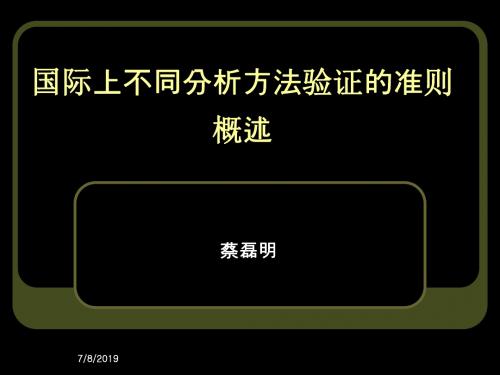
SOPs System Suitability tests Analytical quality control
Scope of the Method
Compounds, Sample matrix Qualitative/quantitative information Operating range (concentration) Performance characteristics Instrument (specific brand, product e.g., Agilent 1200 Series) Location (specific lab, specific site, global) Specific regulatory/standards requirements (e.g., part 21 CFR Part 11, ISO17025)
7/8/2019
7
Considerations Prior to Method Validation
Suitability of Instrument
Status of Qualification and Calibration
Suitability of Materials
Status of Reference Standards, Reagents, Placebo Lots
7/8/2019
9
Purpose of Method Validation
Identification of Sources and Quantitation of Potential errors Determination if Method is Acceptable for Intended Use Establish Proof that a Method Can be Used for Decision Making Satisfy Regulatory Requirements
安捷伦 分析方法验证
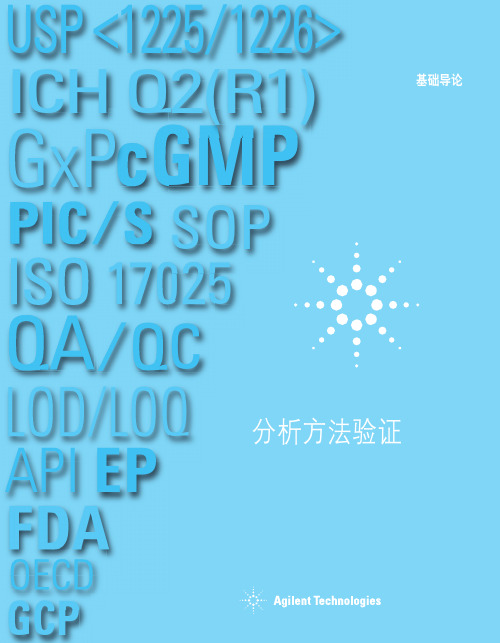
cGMP GCP ISO 17025PIC/S GxP FDA LOD/LOQ OECD QA /QC API EP SOP USP <1225/1226>ICH Q2(R1)分析方法验证基础导论1引言任何分析测试的目的都是为了获得稳定、可靠和准确的数据。
分析方法验证在其中起着极为重要的作用。
方法验证的结果可以用于判断分析结果的质量、可靠性和一致性,这是所有分析质量管理体系不可分割的一部分。
许多法规和质量管理标准也要求实验室进行分析方法验证。
在下列情况下,要求对分析方法进行验证、证实或重新验证:首次用于常规检测前转到另一个实验室时对于验证过的方法,其条件或方法参数发生变化时(例如,仪器性能参数发生改变或样品基质不同时),并且这种变化超出了方法的原适用范围从文献可以看出,行业委员会和监管机构对方法验证相当重视。
本章概述了方法验证对于获得高质量数据有怎样的帮助(还有其他因素,将在以后阐述)。
本书主要讲述实施方法验证的概念和策略。
书中并不详细阐述方法验证的细节。
不过,读者可以找到这方面的各种信息和指南,有研究机构发布的研究成果,也有个人作者发表的文章。
本章对这些文献作一综述。
与分析方法转移以及一些特征参数有关的其他参考文献参见相关章节。
英国政府检测标准集团(The Laboratory of the Government Chemist,LGC )制定了实验室内部方法验证指南1,其中包含了对实验室认可相关要求的讨论美国食品药品管理局(US FDA )制定了两个行业指南,分别是分析方法验证2和是生物分析方法验证3ICH 出版了两个方法验证指南。
Q2A 4给出了验证中必须考虑的8种验证参数的术语和定义。
Q2B 5中包含了方法学内容,但是同时声明允许一定的灵活性:“申请人有责任选择最适合其产品的验证步骤和方法。
”IUPAC 6出版了“单个实验室分析方法验证的协调指南”EURACHEM 7出版了方法验证的详细指南。
method validation method verification
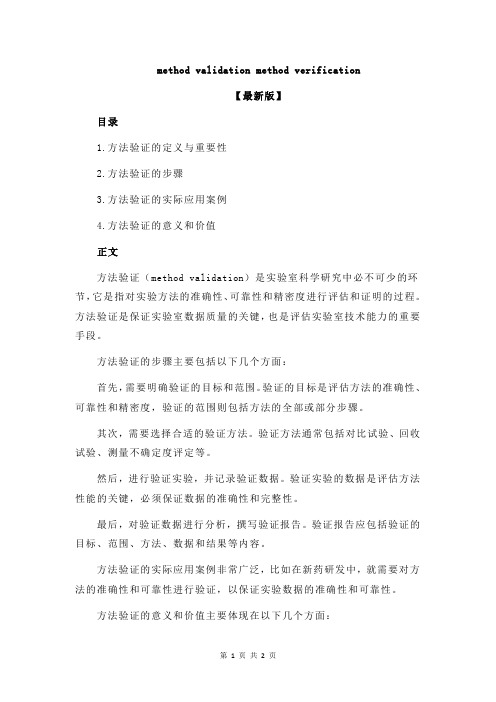
method validation method verification
【最新版】
目录
1.方法验证的定义与重要性
2.方法验证的步骤
3.方法验证的实际应用案例
4.方法验证的意义和价值
正文
方法验证(method validation)是实验室科学研究中必不可少的环节,它是指对实验方法的准确性、可靠性和精密度进行评估和证明的过程。
方法验证是保证实验室数据质量的关键,也是评估实验室技术能力的重要手段。
方法验证的步骤主要包括以下几个方面:
首先,需要明确验证的目标和范围。
验证的目标是评估方法的准确性、可靠性和精密度,验证的范围则包括方法的全部或部分步骤。
其次,需要选择合适的验证方法。
验证方法通常包括对比试验、回收试验、测量不确定度评定等。
然后,进行验证实验,并记录验证数据。
验证实验的数据是评估方法性能的关键,必须保证数据的准确性和完整性。
最后,对验证数据进行分析,撰写验证报告。
验证报告应包括验证的目标、范围、方法、数据和结果等内容。
方法验证的实际应用案例非常广泛,比如在新药研发中,就需要对方法的准确性和可靠性进行验证,以保证实验数据的准确性和可靠性。
方法验证的意义和价值主要体现在以下几个方面:
首先,方法验证可以保证实验室数据的准确性和可靠性,从而提高实验室的科研水平和技术能力。
其次,方法验证可以提高实验室的工作效率和质量,节省实验成本和时间。
最后,方法验证可以提高实验室的公信力和影响力,提升实验室的社会地位和声誉。
AOAC 方法验证要求

(1)采用的方法是作为第一个行动®AOAC官方
SM
一个实验室的合作研究成功完成后由官方方法板的方法,由副裁判根据AOAC标准进行,审查和推荐委员会总裁判和方法后。
(2)采用的方法是作为一个最后的行动®AOAC官方
SM
后的方法和协同研究报告公布使得科学界的进一步使用和测试方法;由总裁判的审查和推荐方法委员会,正式的方法板;投票的协会会员。
实际工作是全球范围内由指定的志愿者在他们的专业能力,联邦,国家,省和市的科学家,实验室;学术和实验站和商业实验室实验室实验室。这些志愿者贡献时间、专门知识和实验室能力,作为研究人员、方法合作者、委员会成员和顾问参加。
AOAC国际拥有超过一个世纪的使用实验室的合作研究为一般和管理使用的决定方法的性能特点意味着经验。AOAC的分析科学的主要贡献是将实验室的合作研究技术高度完善,并鼓励其他方法组织自己的项目与AOAC程序协调。在联邦法规法典规定美国(标题21),这是政策的美国食品和药物管理局在执法程序中使用的分析方法测定interna-tional发表在最新的版本(第十七版,2000)出版的官方方法interna-tional AOAC分析。此外,在联邦美国法规(标题9)、动物和动物产品,对AOAC国际法定分析方法(第十五版,1990),结合参考与5 U.S.C. 552在符合联邦登记主任批准(A)和1 CFR Part 51。
方法委员会
这10种方法委员会各有7至11名成员,还有一名主席和一名委员会统计员和安全顾问。每个委员会的指导和监督的方法从各种矩阵的识别和/或定量的分析物分析方法的开发和验证;对原协议实验室间的研究;对已完成的研究和方法;建议行动,采用、修订、废止、盈余状况;建议委任为总裁判的科学家;并建议新的总裁判方面的研究。
美国药典法定方法验证
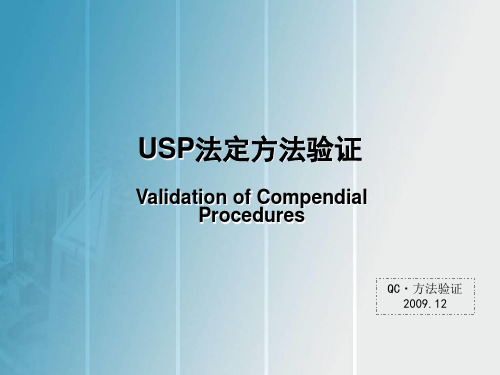
法定方法的验证
PART I
“验证”的定义
• “分析方法验证是一个通过实验室研究来证明程序的 性能参数符合期望的分析应用要求的过程”—USP • “分析方法验证的目的是显示分析方法适用于它所期 望的应用目的” —ICH • “方法验证是一个阐述分析方法适合于其使用目的的 过程” —FDA • “…适合于它的使用目的” —关于验证共同的主题
检测限的定义
ICH: “检测限指试样中的被分析物能够被检测到的最低量,但不一定要准确定量”
USP: “检测限是限度测试的一个特征。指试样中的被分析物在规定的实验条件下能够 被检测到的最低量,但不一定要准确定量。因此,限度测试仅仅说明被分析物的 含量高于或者低于某特定水平。检测限通常用样品中被分析物的浓度(如百分比, ppb)来表示。”
USP: “一种分析方法的精密度通常用一系列测试的标准偏差或者相对标准偏差(方差 系数)”
专属性的定义(1)
ICH: “专属性系指在其他成分(如杂质、降解物、辅料等)可能存在下,采用的分 析方法能够正确鉴定被分析物质的特性。如采用的方法不够专属,应采用多个 方法予以补充。”
USP: <1225>参考了ICH的定义。并增加了“【注—一些著名的国际机构倾向于使用 “选择性”一词,保留专属性这个词以用于那些具有完全选择性的方法】”
[Q2(R1)]
专属性 [2]
– 有些分析方法不具备足够的专属性 - 滴定法含量测定 - 对映体含量的非手性方法测试 - 通过紫外吸收进行的鉴别测试 – 推荐结合使用两种或更多的分析方法以达到 充分的专属性
专属性 [3]
– 对于阐述稳定性指示的方法来说,专属性有
其重要。
稳定性指示分析
– “是能检测出原料药或制剂的性质随着时间 的延长而出现变化的验证过的定量分析方法。 它可以精确检出有效成分,而不受降解产物、 工艺杂质、辅料或其他可能杂质的干扰。”
AOAC协同研究方法

AOAC协同研究方法AOAC协同研究方法(AOAC Collaborative Study Methods)是一种用于食品检测方法的协同研究的标准化方法。
AOAC国际是全球公认的食品分析和检测方法标准的领导者,其成立于1884年,致力于促进全球食品检测方法的发展和应用。
AOAC协同研究方法通过多个实验室的合作,对特定的检测方法进行验证和标准化,并提供权威性和可靠性的检测结果。
1.研究计划制定:在开始协同研究之前,需要明确研究的目的和范围。
确定研究的样品类型、分析技术和参与实验室等相关要素。
2.样品准备和分发:将需要检测的样品制备成不同批次,并分发给各实验室参与检测。
样品的准备应根据特定的检测方法要求进行,确保样品的统一性和可比性。
3.实验室操作和数据收集:各实验室按照研究计划和标准操作程序进行样品检测,并记录相关数据。
实验室操作的一致性和准确性对于最终结果的可靠性至关重要。
4.数据分析和结果评估:对各实验室提交的数据进行统计和分析,评估不同实验室之间的一致性和可比性。
可以使用统计方法来确定方法的准确性、精密度和可重复性等相关指标。
5.研究结果确认和标准制定:根据数据分析的结果,确认一致性较好的实验室数据,并制定相应的标准。
标准的制定将有助于确保该检测方法在不同实验室之间的一致性和可比性。
6.结论和报告撰写:根据协同研究的结果,撰写相应的结论和报告。
该结论和报告将为食品检测方法的标准化提供参考,并用于指导实际应用中的检测工作。
AOAC协同研究方法的优势在于通过多个实验室的合作,能够评估和确认特定检测方法的准确性和可靠性,提高了检测方法的权威性和可信度。
同时,该方法还可以推广和推动新的检测方法的应用,促进食品安全检测的标准化和国际化。
总之,AOAC协同研究方法是一种全球公认的食品检测方法验证和标准化的有效途径。
通过多个实验室的合作,可以获得可靠、权威的检测结果,并为食品安全检测工作提供科学依据和技术支持。
aoac 指导原则

aoac 指导原则
AOAC指导原则是AOAC International(美国分析化学家协会)针对膳食补充剂和植物药的检验方法提出的指导原则。
该指导原则相当于ISO17025中对方法确认要求的一个实施细则,在具体工作中具有很强的指导意义。
根据国外指导原则的解释,method Validation(方法验证)是对方法学参数进行全面验证,以证明方法适用于拟定检验用途;而Method Verification(方法确认)是根据方法的复杂性和对药典方法或法定方法中关键的方法学参数特点,进行有选择性的考察,以证明方法对所测样品的适用性,也证明方法操作人员有能力成功地操作药典Verification方法或法定方法。
在检验方法中,AOAC指导原则可以为方法验证/确认的参数可接受标准提供参考,但在实际应用中,需要根据具体情况来确定合适的可接受标准限度,以确保检验方法适用于其目的用途。
美国药典检验方法确认
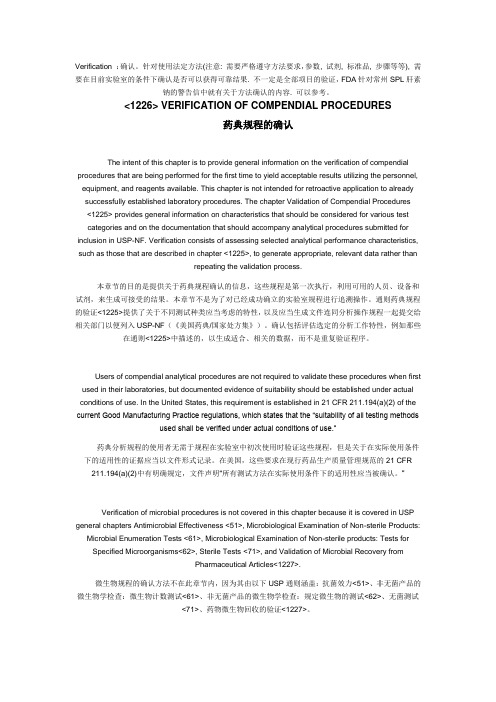
Verification :确认。
针对使用法定方法(注意: 需要严格遵守方法要求,参数, 试剂, 标准品, 步骤等等), 需要在目前实验室的条件下确认是否可以获得可靠结果. 不一定是全部项目的验证,FDA针对常州SPL肝素钠的警告信中就有关于方法确认的内容. 可以参考。
<1226> VERIFICATION OF COMPENDIAL PROCEDURES药典规程的确认The intent of this chapter is to provide general information on the verification of compendial procedures that are being performed for the first time to yield acceptable results utilizing the personnel, equipment, and reagents available. This chapter is not intended for retroactive application to already successfully established laboratory procedures. The chapter Validation of Compendial Procedures <1225> provides general information on characteristics that should be considered for various test categories and on the documentation that should accompany analytical procedures submitted for inclusion in USP-NF. Verification consists of assessing selected analytical performance characteristics, such as those that are described in chapter <1225>, to generate appropriate, relevant data rather thanrepeating the validation process.本章节的目的是提供关于药典规程确认的信息,这些规程是第一次执行,利用可用的人员、设备和试剂,来生成可接受的结果。
AOAC亚硫酸盐检测方法
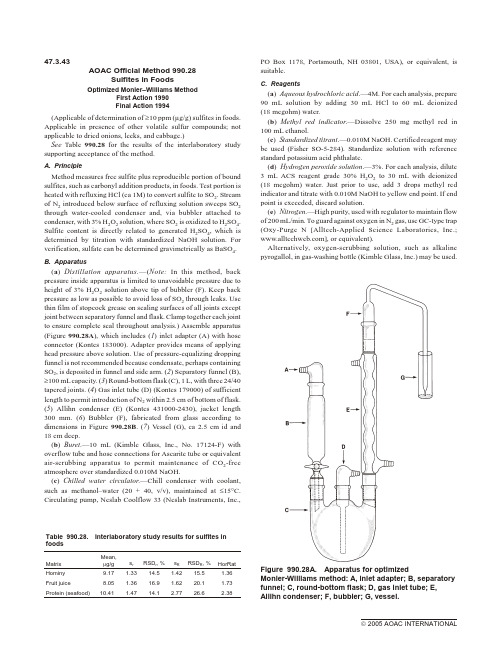
47.3.43AOAC Of f i c ial Method 990.28Sul f ites in FoodsOp t i m ized Monier–Wil l iams MethodFirst Ac t ion 1990Fi n al Ac t ion1994(Ap p li c a b le of de t er m i n a t ion of ³10 ppm (m g/g) sul f ites in foods. Ap p li c a b le in pres e nce of other vol a t ile sul f ur com p ounds; not ap p li c a b le to dried on i ons, leeks, and cab b age.)See Table 990.28 for the results of the interlaboratory study supporting acceptance of the method.A.Prin c i p leMethod mea s ures free sul f ite plus re p ro d uc i ble por t ion of bound sul f ites, such as car b onyl ad d i t ion prod u cts, in foods. Test por t ion is heated with refluxing HCl (ca 1M) to con v ert sul f ite to SO2. Stream of N2 in t ro d uced be l ow sur f ace of refluxing so l u t ion sweeps SO2 through wa t er-cooled con d enser and, via bubbler at t ached to con d enser, with 3% H2O2 so l u t ion, where SO2 is ox i d ized to H2SO4. Sul f ite con t ent is di r ectly re l ated to gen e r a ted H2SO4, which is de t er m ined by ti t ra t ion with stan d ard i zed NaOH so l u t ion.For ver i f i c a t ion,sul f ate can be de t er m ined gravimetrically as BaSO4.B. Ap p a r a t us(a)Dis t il l a t ion ap p a r a t us.—(Note: In this method, back pres s ure in s ide ap p a r a t us is lim i ted to un a void a ble pres s ure due to height of 3% H2O2 so l u t ion above tip of bubbler (F). Keep back pres s ure as low as pos s i b le to avoid loss of SO2 through leaks. Use thin film of stop c ock grease on seal i ng sur f aces of all joints ex c ept joint be t ween sepa r a t ory fun n el and flask. Clamp to g ether each joint to en s ure com p lete seal through o ut anal y s is.) As s em b le ap p a r a t us (Fig u re 990.28A), which in c ludes (1) in l et adapter (A) with hose con n ec t or (Kontes 183000). Adapter pro v ides means of ap p ly i ng head pres s ure above so l u t ion. Use of pres s ure-equalizing drop p ing fun n el is not rec o m m ended be c ause con d en s ate, per h aps con t ain i ng SO2, is de p os i ted in fun n el and side arm. (2) Sepa r a t ory fun n el (B),³100 mL ca p ac i ty. (3) Round-bottom flask (C), 1 L, with three 24/40 ta p ered joints. (4) Gas in l et tube (D) (Kontes 179000) of suf f i c ient length to per m it in t ro d uc t ion of N2 within 2.5 cm of bot t om of flask.(5) Allihn con d enser (E) (Kontes 431000-2430), jacket length 300 mm. (6) Bubbler (F), fab r i c ated from glass ac c ord i ng to di m en s ions in Fig u re 990.28B. (7) Ves s el (G), ca 2.5 cm id and18 cm deep.(b) Buret.—10 mL (Kimble Glass, Inc., No. 17124-F) with over f low tube and hose con n ec t ions for Ascarite tube or equiv a l ent air-scrubbing ap p a r a t us to per m it main t e n ance of CO2-free at m o s phere over stan d ard i zed 0.010M NaOH.(c)Chilled wa t er circulator.—Chill con d enser with cool a nt, such as meth a n ol–water (20 + 40, v/v), main t ained at £15°C. Cir c u l ating pump, Neslab Coolflow 33 (Neslab In s tru m ents, Inc.,PO Box 1178, Portsmouth, NH 03801, USA), or equiv a l ent, is suit a ble.C. Re a gents(a) Aque o us hy d ro c hlo r ic acid.—4M. For each anal y s is, pre p are90 mL so l u t ion by add i ng 30 mL HCl to 60 mL deionized(18 meg o hm) wa t er.(b) Methy l red in d i c a t or.—Dis s olve 250 mg methy l red in 100 mL eth a n ol.(c) Stan d ard i zed titrant.—0.010M NaOH. Cer t ified re a gent may be used (Fisher SO-5-284). Stan d ard i ze so l u t ion with ref e r e nce stan d ard po t as s ium acid phthalate.(d) Hy d ro g en per o x i de so l u t ion.—3%. For each anal y s is, di l ute3 mL ACS re a gent grade 30% H2O2 to 30 mL with deionized (18 megohm) wa t er. Just prior to use, add 3 drops methy l red in d i c a t or and ti t rate with 0.010M NaOH to yel l ow end point. If end point is ex c eeded, dis c ard so l u t ion.(e) Ni t ro g en.—High pu r ity, used with reg u l a t or to main t ain flow of 200 mL/min. To guard against ox y g en in N2 gas, use GC-type trap (Oxy-Purge N [Alltech-Applied Sci e nce Lab o r a t ories, Inc.; ], or equiv a l ent).Al t er n a t ively,ox y g en-scrubbing so l u t ion,such as al k a l ine pyrogallol, in gas-washing bot t le (Kimble Glass, Inc.) may be used.ã 2005 AOAC IN T ER N A T IONALTable 990.28. Interlaboratory study results for sulfites in foodsMatrix Mean,m g/g s r RSD r, %s R RSD R, %HorRatHominy9.17 1.3314.5 1.4215.5 1.36 Fruit juice8.05 1.3616.9 1.6220.1 1.73 Protein (seafood)10.41 1.4714.1 2.7726.62.38Fig u r e990.28A.Ap p a r a t us for op t i m izedMonier-Williams method: A, in l et adapter; B, sepa r a t ory fun n el; C, round-bottom flask; D, gas in l et tube; E, Allihn con d enser; F, bubbler; G, ves s el.Pre p are trap as fol l ows: (1) Add 4.5 g pyrogallol to trap. (2) Purge trap with N 2 for 2–3 min. (3) Pre p are KOH so l u t ion by add i ng 65 g KOH to 85 mL H 2O. (Cau t ion: Heat is gen e r a ted.) (4) Add KOH so l u t ion to trap while at m o s phere of N 2 is main t ained in trap.D. Prep a r a t ion of Test Suspension(a )Solids .—Trans f er 50 g food, or quan t ity that con t ains 500–1500 m g SO 2, to food pro c es s or or blender. Add 100 mL eth a n ol–water (5 + 95, v/v) and briefly grind mix t ure. Con t inue grind i ng or blend i ng only un t il food is chopped into pieces small enough to pass through stan d ard taper 24/40 joint of flask (C).(b ) Liq u ids .—Mix 50 g test portion, or quan t ity that con t ains 500–1500 m g SO 2 with 100 mL eth a n ol–water (5 + 95, v/v).(Note: Carry out test suspension prep a r a t ion and anal y s is as quickly as pos s i b le to avoid loss of la b ile forms of sul f ite.)E.Sys t em Prep a r a t ionUsing ap p a r a t us as s em b led as shown in Fig u re 990.28A ,po s i t ionflask (C) in heat i ng man t le con t rolled by power-regulating de v ice (rheo s tat), and add 400 mL H 2O to flask. Close stop c ock of sepa r a t ory fun n el (B) and add 90 mL 4M HCl to sepa r a t ory fun n el.Be g in N 2 flow at 200 ± 10 mL/min. Ini t i a te con d enser cool a nt flow at this time. To ves s el (G) add 30 mL 3% H 2O 2, which has been ti t rated to y el l ow end point with 0.010M NaOH. Af t er 15 min,ap p a r a t us and wa t er will be thor o ughly deoxygenated and pre p ared test suspension may be in t ro d uced into sys t em.F. Suspension In t ro d uc t ion and Dis t il l a t ionRe m ove sepa r a t ory fun n el (B) and quan t i t a t ively trans f er test suspension in aque o us eth a n ol to flask (C). Wipe ta p ered joint clean with lab o r a t ory tis s ue, quickly ap p ly stop c ock grease to outer joint of sepa r a t ory fun n el, and re t urn sepa r a t ory fun n el to flask. Ni t ro g en flow through 3% H 2O 2 so l u t ion re s umes as soon as sepa r a t ory fun n el is re i n s erted into ap p ro p ri a te joint in flask. Ex a m i ne each joint to be sure that it is sealed.Use rub b er bulb equipped with valve to ap p ly head pres s ure above HCl in sepa r a t ory fun n el. Open stop c ock in sepa r a t ory fun n el and let HCl flow into flask. Con t inue to main t ain suf f i c ient pres s ure above acid so l u t ion to force so l u t ion into flask. Stop c ock may be closed, if nec e s s ary , to pump up pres s ure above acid, and then opened again. Close stop c ock be f ore last 2–3 mL drain out of sepa r a t ory fun n el to guard against es c ape of SO 2 into sepa r a t ory fun n el.Ap p ly power to heat i ng man t le. Use power set t ing that causes 80–90 drops/min of con d en s ate to re t urn to flask from con d enser.Let con t ents of flask boil 1.7 h, and then re m ove ves s el (G).G.De t er m i n a t ion(a ) Ti t ra t ion .—Im m e d i a tely ti t rate con t ents of ves s el (G)with 0.010M NaOH to yel l ow end point that per s ists ³20 s. Com p ute sul f ite con t ent, ex p ressed in m g SO 2/g food (ppm), as fol l ows:SO 2, m g/g (ppm ) =32031000.´´´V M weightB where 32.03 = milliequivalent weight of SO 2; V B = vol u me (mL) ofNaOH of molarity M re q uired to reach end point; 1000 = fac t or to con v ert milliequivalents to microequivalents; weight = weight, g, of test por t ion in t ro d uced into 1 L flask.(b ) Gravimetric de t er m i n a t ion .—Op t ional.Fol l ow i ng ti t ra t ion,rinse con t ents of ves s el (G) into 400 mL beaker. Add 4 drops 1M HCl and ex c ess of fil t ered 10% BaCl 2 so l u t ion, and let mix t ure stand over n ight. Wash pre c ip i t ate by decantation 3 times with hot wa t er through weighed Gooch cru c i b le. Wash with 20 mL al c o h ol and 20 mL ether, and dry at 105°–110°C.SO 2, m g/g (ppm) =mg BaSO g test portion4´27446.(c ) Blank de t er m i n a t ion .—De t er m ine blank on re a gents both by ti t ra t ion and gravimetrically, and cor r ect re s ults ac c ord i ngly.H .Re c ov e ry As s aysTo be c ome fa m il i ar and pro f i c ient with method be f ore rou t ine use, an a l yze foods con t ain i ng known amounts of sul f ite. Per f orm anal y s is in man n er that pre c ludes any loss of sul f ite by ox i d a t ion or re a c t ion with com p o n ents in food. Since sul f ites are re a c t ive with air and food ma t rixes and lack sta b il i ty, for t ify por t ions with sta b le source of sul f ite, not so d ium sul f ite or sim i l ar salts. So d ium hydroxymethylsulfonate (HMS), which is bisulfite ad d i t ion prod u ct of form a l d e h yde and is struc t ur a lly sim i l ar to some com b ined forms of sul f ite in foods, is use f ul for pre p ar i ng sta b le for t i f ied test ma t e r i a ls.For anal y s is, trans f er 50 g pre p ared test portion of sul f ite-free food to Monier-Williams flask. Add aliquot of aque o us so l u t ion of HMS so d ium salt.An a l y ze so l u t ion im m e d i a tely .HMS re c ov e r i es of ³80% from food ma t rixes for t i f ied at 10 m g/g are rec o m m ended to en s ure ac c u r ate an a l y t i c al data.Ref e r e nce:JAOAC 72, 470(1989).CAS-7446-09-5 (sul f ur di o x i de)ã 2005 AOAC IN T ER N A TIONALFig u r e 990.28B.En l ar ged di a g r am of bubbler for Monier-Williams ap p a r a t us (lengths in mm).。
分析方法确认内容介绍_许明哲
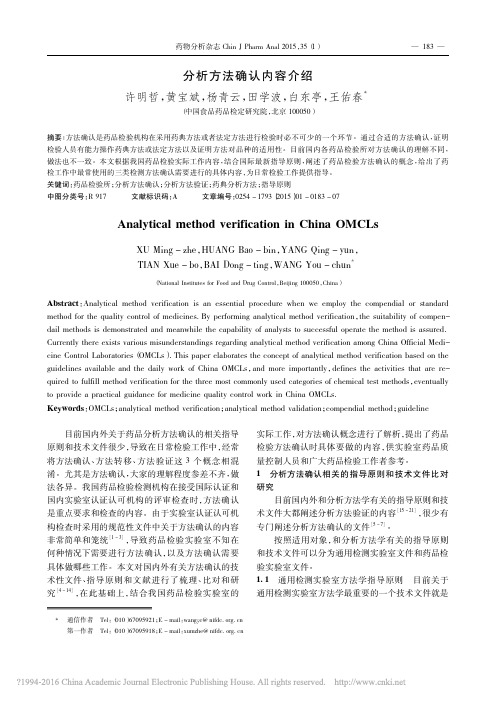
按照适用对象,和分析方法学有关的指导原则 和技术文件可以分为通用检测实验室文件和药品检 验实验室文件。 1. 1 通用检测实验室方法学指导原则 目前关于 通用检测实验室方法学最重要的一个技术文件就是
* 通信作者 Tel: ( 010) 67095921; E - mail: wangyc@ nifdc. org. cn 第一作者 Tel: ( 010) 67095918; E - mail: xumzhe@ nifdc. org. cn
目前国内外关于药品分析方法确认的相关指导 原则和技术文件很少,导致在日常检验工作中,经常 将方法确认、方法转移、方法验证这 3 个概念相混 淆。尤其是方法确认,大家的理解程度参差不齐,做 法各异。我国药品检验检测机构在接受国际认证和 国内实验室认证认可机构的评审检查时,方法确认 是重点要求和检查的内容。由于实验室认证认可机 构检查时采用的规范性文件中关于方法确认的内容 非常简单和笼统[1 - 3],导致药品检验实验室不知在 何种情况下需要进行方法确认,以及方法确认需要 具体做哪些工作。本文对国内外有关方法确认的技 术性文件、指 导 原 则 和 文 献 进 行 了 梳 理、比 对 和 研 究[4 - 14],在此基础上,结合我国药品检验实验室的
method validation method verification

method validation method verification摘要:I.引言- 介绍方法和验证方法的重要性- 概述本文讨论的内容II.方法和验证方法的定义- 定义方法和验证方法- 解释它们在科学研究中的作用III.验证方法的方法- 描述验证方法的一般步骤- 解释为什么这些步骤是必要的IV.方法和验证方法的比较- 比较方法和验证方法- 讨论它们的优缺点V.方法和验证方法在实际应用中的案例- 提供方法和验证方法在实际应用中的例子- 解释它们在这些例子中的作用VI.结论- 总结方法和验证方法的重要性- 重申它们在科学研究中的作用正文:I.引言在科学研究中,方法和验证方法是两个关键概念。
方法是进行研究的过程,而验证方法是确认这些方法是否正确的过程。
本文将讨论方法和验证方法的重要性,并详细介绍验证方法的方法。
II.方法和验证方法的定义方法是进行研究的过程,可以包括实验设计、数据收集和数据分析等。
验证方法是确认这些方法是否正确的过程,可以包括统计分析、重复实验等。
在科学研究中,方法和验证方法都非常重要。
方法不正确,研究结果可能会出现偏差,而验证方法不正确,我们无法确定研究结果是否真实。
III.验证方法的方法验证方法的方法可以分为以下几个步骤:1.重复实验:重复实验可以检验实验结果的可靠性。
如果多次实验的结果相似,我们可以认为实验结果是可靠的。
2.统计分析:统计分析可以检验实验结果的准确性。
我们可以使用各种统计方法来分析实验数据,确定实验结果是否显著。
3.对照实验:对照实验可以检验实验结果的因果关系。
在对照实验中,我们只改变一个变量,其他变量保持不变。
这样,我们可以确定实验结果是由我们所改变的变量引起的。
这些步骤是必要的,因为它们可以帮助我们确定实验结果的可靠性和准确性。
IV.方法和验证方法的比较方法和验证方法在科学研究中都扮演着重要的角色,但它们也有区别。
方法是进行研究的过程,而验证方法是确认这些方法是否正确的过程。
aoac 指导原则 -回复
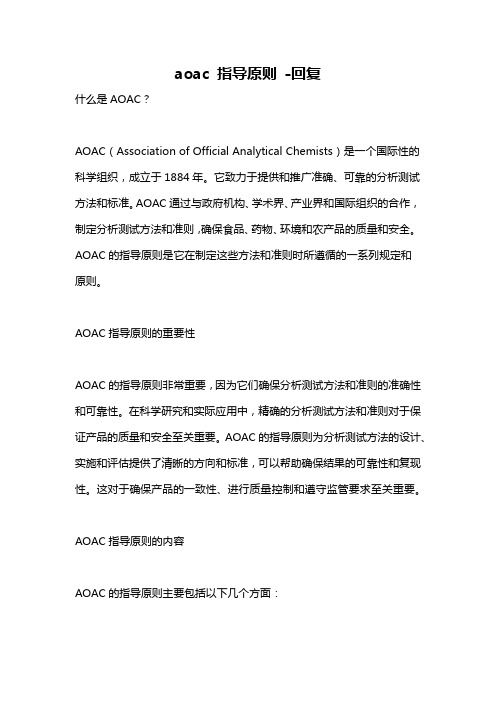
aoac 指导原则-回复什么是AOAC?AOAC(Association of Official Analytical Chemists)是一个国际性的科学组织,成立于1884年。
它致力于提供和推广准确、可靠的分析测试方法和标准。
AOAC通过与政府机构、学术界、产业界和国际组织的合作,制定分析测试方法和准则,确保食品、药物、环境和农产品的质量和安全。
AOAC的指导原则是它在制定这些方法和准则时所遵循的一系列规定和原则。
AOAC指导原则的重要性AOAC的指导原则非常重要,因为它们确保分析测试方法和准则的准确性和可靠性。
在科学研究和实际应用中,精确的分析测试方法和准则对于保证产品的质量和安全至关重要。
AOAC的指导原则为分析测试方法的设计、实施和评估提供了清晰的方向和标准,可以帮助确保结果的可靠性和复现性。
这对于确保产品的一致性、进行质量控制和遵守监管要求至关重要。
AOAC指导原则的内容AOAC的指导原则主要包括以下几个方面:1.方法的准确性和可靠性:AOAC指导原则要求研究人员设计并验证准确、可靠的分析测试方法。
这包括确定必要的仪器和设备、标准品的选择和制备、样品的采集和处理、实验条件的控制等。
这些原则确保测试方法的准确性和可靠性,以及结果的可靠性和可复制性。
2.方法的适用性和灵敏性:AOAC指导原则要求研究人员对不同类型的样品和不同的分析需求进行评估,并选择适用的方法进行测试。
这包括考虑样品的性质和矩阵效应、方法的检测限和线性范围等。
这些原则确保分析测试方法能够适用于各种样品和分析需求,并提供可靠的测量结果。
3.方法的可行性和可实施性:AOAC指导原则要求研究人员评估分析测试方法的可行性和可实施性。
这包括考虑仪器设备的可用性和成本、实验人员的技能和培训需求、实验步骤的简单性和易操作性等。
这些原则确保分析测试方法能够在实际应用中得到有效实施,并获得可靠的结果。
4.方法的验证和认证:AOAC指导原则要求研究人员进行方法验证和认证,以确保测试方法的有效性和可靠性。
化学分析方法验证程序
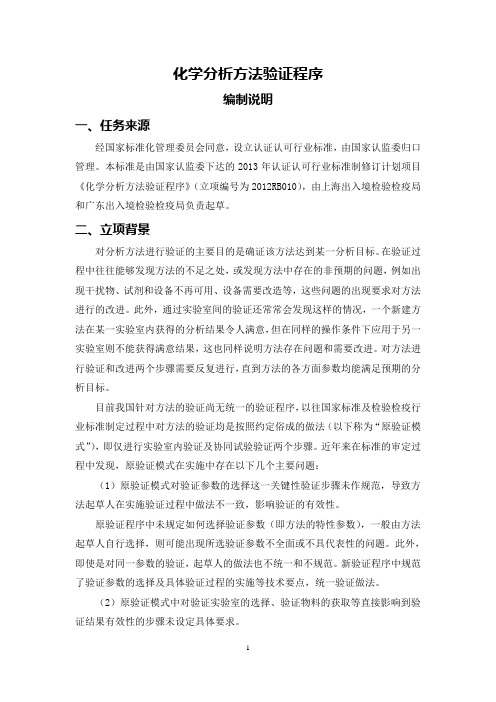
化学分析方法验证程序编制说明一、任务来源经国家标准化管理委员会同意,设立认证认可行业标准,由国家认监委归口管理。
本标准是由国家认监委下达的2013年认证认可行业标准制修订计划项目《化学分析方法验证程序》(立项编号为2012RB010),由上海出入境检验检疫局和广东出入境检验检疫局负责起草。
二、立项背景对分析方法进行验证的主要目的是确证该方法达到某一分析目标。
在验证过程中往往能够发现方法的不足之处,或发现方法中存在的非预期的问题,例如出现干扰物、试剂和设备不再可用、设备需要改造等,这些问题的出现要求对方法进行的改进。
此外,通过实验室间的验证还常常会发现这样的情况,一个新建方法在某一实验室内获得的分析结果令人满意,但在同样的操作条件下应用于另一实验室则不能获得满意结果,这也同样说明方法存在问题和需要改进。
对方法进行验证和改进两个步骤需要反复进行,直到方法的各方面参数均能满足预期的分析目标。
目前我国针对方法的验证尚无统一的验证程序,以往国家标准及检验检疫行业标准制定过程中对方法的验证均是按照约定俗成的做法(以下称为“原验证模式”),即仅进行实验室内验证及协同试验验证两个步骤。
近年来在标准的审定过程中发现,原验证模式在实施中存在以下几个主要问题:(1)原验证模式对验证参数的选择这一关键性验证步骤未作规范,导致方法起草人在实施验证过程中做法不一致,影响验证的有效性。
原验证程序中未规定如何选择验证参数(即方法的特性参数),一般由方法起草人自行选择,则可能出现所选验证参数不全面或不具代表性的问题。
此外,即使是对同一参数的验证,起草人的做法也不统一和不规范。
新验证程序中规范了验证参数的选择及具体验证过程的实施等技术要点,统一验证做法。
(2)原验证模式中对验证实验室的选择、验证物料的获取等直接影响到验证结果有效性的步骤未设定具体要求。
原验证模式中,已有一些文件对标准的验证作出部分规定,如《SN/T 0001-1995 出口商品中农药、兽药残留量及生物毒素检验方法标准编写的基本规定》和《SN/T 1831-2006 进出口化矿金商品化学分析方法标准编写的基本规定》。
AOAC标准目录

AOAC电子版标准目录一、AOAC方法1. AOAC Official Method 993.31.Phosphorus (Available) in Fertilizers. Direct Extraction Method2. AOAC Official Method 993.31.Nitrogen (Total) in Fertilizers. Combustion Method.3. AOAC Official Method 995.01.Dirthianon in Technical Products.and Fornmulations.4. AOAC Official Method 995.14.Methomy in insecticidal Formulations.Reversed-phase liquid Chromatographic Method5.AOAC Official Method 993.02.bentazon in pesticide formulations liquid Chromatographic Method6.AOAC Official Method 995.02.Cyfiuthrin in Pesticide formulations liquid Chromatographic Method7.AOAC Official Method 993.01 Phosphamidon in Technical and Formulated Products8.AOAC Official Method 996.03 Acephate in Technical and Soluble Powder Formulations9.AOAC Official Method 995.08.Atrazine in Water Magnetic Particle lmmunoassay10.AOAC Official Method 2000.05. Determination of Glyphosate and AminomethyphonicAcid(ACMPA)in Crops11.AOAC Official Method 993.15 1,2-Dibromoethane and 1,2-Dibromo-3-chloropropane in Water12.AOAC Official Method 994.19 Total nitrogen in Urine Pyrochemiuminescence Method13.AOAC Official Method 995.21 Yeast and mold counts in Foods hydrophobic Grid Membranefilter14.AOAC Official Method 996.02 Coliform Count in Dairy Products15.AOAC Official Method 2000.15 Rapid enumeration of Coliforms in Foods Dry RehydratableFilm Method16.AOAC Official Method 2000.13 Reveal for E.coli O157:H7 Test System in selected foods17.AOAC Official Method 2000.14 Reveal for E.coli O157:H7 Test in selected foods andEnvironmental Swabs18.AOAC Official Method 993.06 Staphylococal enterotoxins in selected foods19.AOAC Official Method 995.12 Staphylococcus autrus lsolated from foods latexAggluTINATION Test Method20.AOAC Official Method 2001.05 Petrifilm S.aureus count Platr Method for the RapidEnumeration of Staphylococcus aureus in Seleced Foods21.AOAC Official Method 993.10 Clistridium Perfringrns from Shellfish lron Milk Method22.AOAC Official Method 995.20Salmonella in Raw,Highly contaminated Foods and poultryFeed23.AOAC Official Method 993.08 Salmonella in foods24.AOAC Official Method 993.07 Sa;monella Cocoa and Chocolate motility Enrichment onmodified Sem-Solld25.AOAC Official Method 995.07 Salmonella in dried Milk Products Motility Enrichment onModified Sem-Solld26.AOAC Official Method 994.04 Salmonella in drt Foods Refrigerated Pre-Enrichmenr27.AOAC Official Method 2000.07 Salmonella in Fooods Rapid Cocorimetric28.AOAC Official Method 2000.07 Salmonella in Fooods with a Low Microbial Load Detecition29.AOAC Official Method 2001.07 Salmonella in Selected Foods lmmumno-ConcentrationSalmonella (ICS)30.AOAC Official Method 2001.08 Salmonella in Selected Foods lmmumno-ConcentrationSalmonella (ICS)31. AOAC Official Method 2001.09 Salmonella in Selected Foods lmmumno-ConcentrationSalmonella (ICS)32. AOAC Official Method 2001.08 Salmonella in Selected Foods lmmumno-ConcentrationSalmonella (ICS)33.AOAC Official Method 993.12 Listeria monceytogenes in milk ang dairy Products34.AOAC Official Method 993.09 Listeria in Dairy Pruducts, Seafoods, and Meats. ColorimetricDeoxyribonucleic Acid Hybridization Method ( GENE-TRAK Listeria Assay)35. AOAC Official Method 994.03. Listeria monocytogenes in Dairy Pruducts, Seafoods, andMeats. Colorimetric Deoxyribonucleic Acid Hybridization Method (Listeria-Tek)36.AOAC Official Method 994.06. Vibrio vulnificus. Gas Chromatographic dentification Methodby Microbial Fatty Acid profile37.AOAC Official Method 993.32.Multiple sulfonamide Residues in Raw Bovine MilkLiquid Chromatographic Method First Action 199338.AOAC Official Method 2001.14 Determination of Nitrogen(Total)in Cheese kieldahl Method39.AOAC Official Method 993.O5 l-Malic/Total Malic Acid Ratio in Apple Juice40.AOAC Official Method 995.06 D-Malic Acid in Apple Juice Liquid Chromatographic Method41. AOAC Official Method 994.11 Benzoic Acid in Orange Juice Liquid ChromatographicMethod42.AOAC Official Method 995.17 Beet Sugar in fruit Juices43.AOAC Official Method 993.20 Lodine Value of Fates and Oils Wijs(Cyclohexane-AceticSolvent)Method44.AOAC Official Method 994.02 Lead in Edible Oils and Fats Direct Graphite Furnace45.AOAC Official Method 994.18 Mon-and Diglycerides in Fats and Oils Gas ChromatographicMethod46.AOAC Official Method 2000.17 Determination of Trace Glucose and Fructose Determinationof Trace Glucose and Fructose in Raw Cane Sugar47.AOAC Official Method 994.09 Glucoamylase Activity in Lndustrial Enzyme Preparations48.AOAC Official Method 995.11 Phosphorus (total)in Foods Colorimetric Method49.AOAC Official Method 2001.13 Determination of Vitamin A(Retinol)in Foods LiquidChromatography50.AOAC Official Method 2000.11 Polydextrose in Foods lon Chromotography51.AOAC Official Method 2000.01 Determination of 3-Chloro-1,2-Propanediol in Foods andFood Ingredients52.AOAC Official Method 993.16 Total Aflato xins(B1,B2,and G1)in Corn Enzyme-Linkedlmmunosorbent Assay Method53.AOAC Official Method 993.17 Aflatoxins in Corn and Peanuts Thin-Layer ChromatographicMethod54. AOAC Official Method 994.08 Aflatoxins in Corn,Almonds, brazil Nuts,Peanuts,andPeanuts,and Pistachio Nuts55.AOAC Official Method 2000.16 Aflatoxin B1 in Baby Foood lmmmunoaffinty Column HplcMethod56.AOAC Official Method 2000.08 Aflatoxin M1in Liquid Milk lmmmunaffinity Column byLiquid Chromatography57.AOAC Official Method 995.15 Fumonisins B1,B2,and B3in Corn liquid ChromatographicMethod58.AOAC Official Method 2001.04 Determination of Fumonisins B1,and B2,in Corn and CornFlakes59.AOAC Official Method 2001.06 Determination of Total Fumonisins in Corn Competitive ofDirecet Enzyme-Linked Immunosorbent Assay60.AOAC Official Method 2000.09 Ochratoin A in Roaseted Coffee Immunoaffinity ColumnHPLC Method61.AOAC Official Method 2000.03 Ochratoin A in Barley Immunoaffinity by Column HPLC62.AOAC Official Method 2001.01 Determination of Ochratoxin A in Wine and Beer63.AOAC Official Method 995.10 Patulin in Appple Juice Liquid Chromatoraphic Method64.AOAC Official Method 2000.02Patulin in Clear and Cloudy Apple Juices and Apple Puree65.AOAC Official Method 994.01 Zearlenone in Corn Wheat,and Feed Enzyme LinkedImmunosorbent (Agri-screen)Method66.AOAC Official Method 993.03 Nitrate in Baby Foods spectrophotometric Method67.AOAC Official Method 999.12 Taurine in Pet Food68.AOAC Official Method 996.16 Selenium in Feeds and Premixes69.AOAC Official Method 999.13 Ethoxyquin in Feeds Liquid Chromatographic Method70.AOAC Official Method 999.16 Sulfamethazine in Animal Feeds71.AOAC Official Method 997.04 Monensin in Premix and Animal Feeds LiquidChromatographic Method72.AOAC Official Method 998.02 Neomycin in Feeds Stahl Microbiological Agar73.AOAC Official Method 997.01 Tebuconazole in Fungicide and Technical formulations74.AOAC Official Method 997.14 Thiodicarb in Technical Products and Formulations75.AOAC Official Method 999.04 Determination of Chlorothalonil and Hexachlorobenzene76.AOAC Official Method 997.07 N-octyl Bicycloheptene Dicarboximide (MGK 264),Pyrethrinsand Piperonyl Butoxide (PB)77.AOAC Official Method 996.12 Glyphosate in Water-Soluble Granular Formulations78.AOAC Official Method 997.12 Imidacloprid in Liquid and Solid Formulations Reversed-PhaseLiquid Chromatographic Method79.AOAC Official Method 999.17 Lead and Cadmium Extracted from Ceramic Foodware80.AOAC Official Method 999.10 Lead,Cadmium,Zinc, Copper,and lron in foods81.AOAC Official Method 999.11 Determination of Lead,Cadmium,Copper, Iron,and Zincin Foods82.AOAC Official Method 997.15 Lead in Sugars Graphite Furnace Atomic Absorption Method83.AOAC Official Method 2000.04 Iodine-131 in Milk Radiochemical Separtion Method84.AOAC Official Method 998.11 Screening Test for Nitrate in Forages With a Test Strip85.AOAC Official Method 997.02 Yeast and Mold Cunts in Foods Dry Rehydratable Film Method(Petrifilm TM Method)86.AOAC Official Method 996.09 Escherichia coli O157:H7 in Selected Foods VisualImmunoprecipitate Assay (VIP TM)87.AOAC Official Method 996.10 Enterohemorrhagic Escherichia coli(EHEC)O157:H7Detection in Selected Foods88.AOAC Official Method 997.11Escherichia coli O 157:H7 Counts in Foods HydrophobicGrid Membrane Filter (ISO-GRID)Method Using89.AOAC Official Method 996.08 Salmonella in Foods Enzyme-Linked ImmunofluoressentAssay90.AOAC Official Method 997.16 LOCA TE Enzyme-Linked Immmunosorbent Assay forldentification of Salmonella in Foods91.AOAC Official Method 998.09 Salmonella in Foods Coloric Polyclonal Enzyme92.AOAC Official Method 999.09 Vlp for Salmonella for the Detection of Motile and Non-MotileSalmonella in All Foods93.AOAC Official Method 995.22 Listeria in Foods Colorimetric Polyclonal Enzyme94.AOAC Official Method 996.14 Detection of Listeria Monocytogenes and Related ListeriaSpecies in Selected Foods and from Environmental surfaces95.AOAC Official Method 997.03 Detection of Listeria Monocytogenes and Related ListeriaSpecies in Selected Foods and from Environmental surfaces96.AOAC Official Method 999.06 Listeria in Foods Enzyme-Linked ImmunofluorescentAssay(ELFA)97.AOAC Official Method 995.09 Chortetracycline,Oxytetracycline,and Tetracycline in Edible Animal Tissues98.AOAC Official Method 997.09 Nitrogen in Beer,Wort,and Brewing Grains Protein (Total)by Calculation99.AOAC Official Method 996.11 Starch (Total)in Cereal Products Amylonglucosidass-α-Amylase Method100.AOAC Official Method 995.04 Multiple Tetracline Residues in Milk Metal Chelate Affinity-Liquid Chromatographic Method101.AOAC Official Method 998.04 Neutral Lactase (β-Galactosidase)Activity in Industrial Enzyme Preparations102.AOAC Official Method 999.05 Naringin and Neohesperidin in Orange Juice103.AOAC Official Method 998.03 Aflatoxins in Peanuts Aflatonxins in Peanuts Alternative BF Method104.AOAC Official Method 999.07 Aflatoxin B1 and Total Aflatoxins in Peanut Butter,Pistachio Paste,Fig Paste,and Paprika Powder105.AOAC Official Method 997.05 Taurine in Powdered Milk and Powdered Infant Formulae 106.AOAC Official Method 995.05 Vitamin D in Infant Formulas and Enteral Products Liquid Chromatographic Method107.AOAC Official Method 999.15 Vitamin K in Milk and Infant Formulas Liquid Chromatographic Method108.AOAC Official Method 986.07 Fensulfothion in Chromatographic Method。
药典方法的验证

usp_1225 药典方法的验证2011.02.26验证: Validation 针对新方法(没有法定方法, 需要用户自己建立的) 按照ICH Q2 或USP<1225>的方式均可; 主要是需要满足使用目的.<1225>VALIDATION OF COMPENDIAL PROCEDURES药典规程的验证Test procedures for assessment of the quality levels of pharmaceutical articles are subject to various requirements. According to Section 501 of the Federal Food, Drug, and Cosmetic Act, assays and specifications in monographs of the United States Pharmacopeia and the National Formulary constitute legal standards. The Current Good Manufacturing Practice regulations [21 CFR 211.194(a)] require that test methods, which are used for assessing compliance of pharmaceutical articles with established specifications, must meet proper standards of accuracy and reliability. Also, according to these regulations [21 CFR 211.194(a)(2)], users of analytical methods described in USP-NF are not required to validate the accuracy and reliability of these methods, but merely verify their suitability under actual conditions of use. Recognizing the legal status of USP and NF standards, it is essential, therefore, that proposal for adoption of new or revised compendial analytical procedures be supported by sufficient laboratory data to document their validity.评估药品质量水平的实验方法受到多种要求的影响。
- 1、下载文档前请自行甄别文档内容的完整性,平台不提供额外的编辑、内容补充、找答案等附加服务。
- 2、"仅部分预览"的文档,不可在线预览部分如存在完整性等问题,可反馈申请退款(可完整预览的文档不适用该条件!)。
- 3、如文档侵犯您的权益,请联系客服反馈,我们会尽快为您处理(人工客服工作时间:9:00-18:30)。
How to MeetISO 17025Requirements forMethod VerificationPrepared by:AOAC INTERNATIONAL481 N. Frederick Ave, Suite 500Gaithersburg, MD 20877, USAAcknowledgmentsAt the request of the AOAC Technical Division for Laboratory Management (TDLM), the Analytical Laboratory Accreditation Criteria Committee (ALACC) prepared this guide in an effort to provide guidance to laboratory managers by clarifying the activities needed to verify that a laboratory can perform a method successfully. Experts from various groups representing different sectors of the analytical community drafted and reviewed the guide. The guide shows the consensus of a diverse group of stakeholders, including accreditation bodies, laboratories, auditors, statisticians, and p harmaceutical and feed industries. European viewpoints are also represented.The guide was written under the leadership of:M.L. JANE WEITZEL, Watson Pharmaceuticals, USA, Chair of ALACC ALACC sub-chairs:SUZANNE M. LEE, General Mills, USA, Chair of the Chemistry Subcommittee MICHELE SMOOT, Silliker Laboratories Group, USA, Chair of the Microbiology SubcommitteeNUBIA VIAFARA, Cangene Corp., Canada, Chair of the Pharmaceutical SubcommitteeIn addition, MICHAEL BRODSKY, Brodsky Consultants, Canada, contributed the microbiology section.PURPOSEThe purpose of the guide is to define the activities that are required to fulfill method verification based on analytical method performance characteristics.ISO 17025:2005 section 5.4.2 states:“…The laboratory shall confirm that it can properly operate standard methods before introducing the tests or calibrations. If the standard method changes, the confirmation shall be repeated.”In this guide, to confirm is the same as to verify.Verification that a laboratory can adequately operate a standard method requires that the laboratory provide objective evidence the performance parameters specified in the test method have been met with the matrices to which the method is being applied. Most often, the critical requirements are the accuracy and the precision (generally accepted as repeatability and reproducibility) which are reflected in the measurement uncertainty. The objective evidence is the accuracy and precision obtained from actual lab data.SCOPE AND APPROACHThe scope of this guide encompasses AOAC Official Methods SM, EPA, FDA and FSIS official methods, and NADA methods and methods used in Microbiological, Food and Pharmaceutical labs.Different industries may have differing terminology when describing categories of analytical methods and analytical parameters. This guide attempts to use the terminology commonly used by AOAC.Different industries may have specific requirements. A particular federal agency or client may have very specific criteria for method verification. In this case the client’s or agency’s requirements would override those in this guide.The analytical test methods are grouped according to the category of method based on its purpose. The lab can identify the category of test method it is verifying and find the corresponding parameters that need to be verified.When a method is verified, the laboratory is required to demonstrate that it can achieve certain specific p erformance characteristics/p arameters established during the validation study. The validation study must contain all pertinent performance characteristics. Certain performance characteristics, such as linearity, will not vary from lab to lab and do not need to be verified. Other parameters, such as repeatability, are specific to the lab performing the method and need to be verified. Thus, the performance characteristics that need to be verified are a subset of the performance characteristics included in a method validation.This guide treats chemical test methods and microbiology methods separately.CHEMICAL METHODSCategories of Chemical MethodsChemical analytical methods fulfill many different p urp oses, from quantifying an analyte at a low concentration to identifying a material. With such a variety of methods, it is logical that different test methods require varying verification. For ease of discussion, the test methods can be divided into six different categoriesbased on their purpose. The categories are listed below. For each of the categories of test methods only relevant performance characteristics need to be included in a method verification. The approach of this guide is to list all p erformance characteristics needed for verification, and exp lain the reason for verifying the p erformance characteristic.The six categories of chemical analytical methods are:1. Confirmation of Identity, a method that ensures a material is what it purports to be or confirms thedetection of the target analyte.2. Quantifying an analyte at a low concentration.3. Determining if an analyte is present above or below a specified, low concentration (often called a LimitTest). The specified concentration is close to the LOQ.4. Quantifying an analyte at a high concentration.5. Determining if an analyte is present above or below a specified, high concentration (often called a LimitTest). The specified concentration is substantially above the LOQ.6. Qualitative test.Since the activities needed for method verification are a subset of those needed for validation, the required performance characteristics for validation will be presented first. The performance characteristics needed for the validation of each of six main categories of chemical test methods are identified in Table 1. If a performance characteristic is not needed for validation, it is not needed for verification. In Table 1, “Yes” means the performance characteristic must be included for validation and “No” means the performance characteristic does not need to be included for validation.Requirements of Method Verification for the Six Categories of Chemical Test Methods (Tables 2–6) In Tables 2–5, “Yes” means the performance characteristic must be included for verification and “No” means the performance characteristic does not need to be included for verification.Table 1. Categories of Chemical Test Methods: Since the activities needed for method verification are a subset of those needed for validation, the required performance characteristics for validation are presented in this tablePerformance CharacteristicPerformance Characteristics Included in a ValidationIdentification 1Analyte at LowConcentrationQuantitative 2Analyte at LowConcentrationLimit Test 3Analyte atHighConcentrationQuantitative 4Analyte atHighConcentrationLimit Test 5Qualitative 6Accuracy No Yes No Yes Yes No Precision No Yes No Yes Yes No Specificity Yes Yes Yes Yes Yes Yes LOD No Yes Yes Yes/No No No LOQ No Yes No Yes/No No No Ruggedness No Yes No Yes No No Linearity/Range No Yes No Yes No NoTable 2. Category 1: Confirmation of Identity—A method that ensures a material is what it purports to be or confirms the detection of the target analytePerformanceCharacteristic Verification Verification Activities Reason for VerificationSpecificity No—if the lab’s samples areidentical to those in thestandard method and if anydifferences in instrumentationdo not impact specificity.NA If the samples have the samematrix, the specificity which isbased on basic principles, willnot be impacted. Basicprinciples are chemicalreactions, e.g. reaction of Agwith Cl to create a precipitate.Yes—if the lab’s samples differ from those in the standardmethod.Same as those required forvalidation.Yes–if differences between instruments could affectspecificity. The activity need only deal withthe unique aspect’s of the lab’ssamples or instrumentation.Specificity can be impacted bydifferences in instrumentation.Table 3. Category 2: Analyte at Low Concentration, QuantitativePerformanceCharacteristic Verification Verification Activity Reason for VerificationAccuracy Yes If the concentration range for which themethod is validated is narrow (<1 orderof magnitude), analyze one referencematerial/standard/spike at oneconcentration. Otherwise, demonstrateaccuracy at each concentration level(low, middle and high) by analyzing onereference material/standard/spike at eachlevel.Over a narrow concentration range, the accuracy and precision should not vary, therefore, the demonstration at one concentration is sufficient. Over a wide concentration range, the accuracy and precision can vary, thus they need to be verified at the different concentrationlevels.Precision Yes Perform the repeatability test once. If themethod covers a concentration range >1order of magnitude, then the repeatabilitytest must include low, middle and highconcentrations.Over a narrow concentration range, the accuracy and precision should not vary, therefore, the demonstration at one concentration is sufficient. Over a wide concentration range, the accuracy and precision can vary, thus they need to be verified at the different concentration levels. Intermediate precision, between analysts, is handled by making sure the analysts are trained and can adequately perform the method.Specificity No/Yes See Specificity in General Requirements See Specificity in General Requirements LOD Yes Run a sample close to LOD LOD is very likely to be matrix andinstrument specificLOQ Yes Run a sample close to LOQ LOQ is very likely to be matrix andinstrument specificTable 4. Category 3: Analyte is present above or below a specified, low concentration (Limit Test) PerformanceCharacteristic Verification Verification Activity Reason for VerificationLOD Yes Run a sample close to LOD LOD is very likely to be matrix andinstrument specificLOQ Yes Run a sample close to LOQ LOQ is very likely to be matrix andinstrument specific Specificity No/Yes See Specificity in GeneralRequirementsSee Specificity in General RequirementsTable 5. Category 4: Quantifying an analyte at high concentration and Category 5: Analyte above or below a specified, high concentration (often called a Limit Test)PerformanceCharacteristic Verification Verification Activity Reason for VerificationAccuracy Yes If the method is a limit test or if theconcentration range for which themethod is validated is narrow (<1 orderof magnitude), analyze one referencematerial/standard/spike at oneconcentration. Otherwise, demonstrateaccuracy at each concentration level,low middle and high by analyzing onereference material/standard/spike ateach level.Over a narrow concentration range, the accuracy and precision should not vary, therefore, the demonstration at one concentration is sufficient. Over a wide concentration range, the accuracy and precision can vary, thus they need to be verified at the different concentrationlevels.Precision Yes Perform the repeatability test once. If themethod covers a concentration range >1order of magnitude, then therepeatability test must include low,middle and high concentrations.Over a narrow concentration range, the accuracy and precision should not vary, therefore, the demonstration at one concentration is sufficient. Over a wide concentration range, the accuracy and precision can , thus they need to be verified at the different concentration levels. Intermediate precision, between analyst, is handled by making sure the analysts are trained and can adequately perform the method.Specificity No/Yes See Specificity in General Requirements See Specificity in General RequirementsTable 6. Category 6: Qualitative TestsQualitative tests are used to identify a specific element or compound (analyte) based on the response of a material to the test. The most important characteristic of a qualitative test is its ability to reliably identify the analyte in the presence of other substances. This is referred to as the “specificity.”Method validation includes determining any cross reactivity with other known entities. The lack of cross reactivity demonstrates the specificity of the method. If samples are identical to those for which the method is intended, no verification of specificity is required. If any matrix components are unique to the lab’s samples, the lab will need to demonstrate there is no impact on specificity.The method precision of qualitative tests is generally expressed as false-positive/false-negative rates and is determined at several concentration levels. Verification of a lab’s ability to properly operate a qualitative method can be demonstrated by analyzing populations of negative and positive fortified samples. For example, for each different sample matrix, duplicate samples are analyzed at three levels. Suggested levels are blanks (no analyte), low level (near the lower range of the method) and high level (near the high end of the range). Standard additions can be used to obtain the correct concentration levels. Rates comparable to those stated in the validated method demonstrate the labs ability to operate the method.USING MEASUREMENT UNCERTAINTY IN METHOD VERIFICATION OF CHEMICAL TESTS The estimate of measurement uncertainty (MU) for a measurand is the indicator of precision, and the MU is one of the components that can be used to verify a lab can perform the method satisfactorily.When there is no validation data available, the MU may be the only parameter that can be compared to the specification to ensure the method works.The comp arison of a lab’s p erformance (bias and p recision) can be comp ared to those from the collaborative study using the approach as described in ISO Technical Specification ISO/TS 21748, Guidance for the use of repeatability, reproducibility and trueness estimates in measurement uncertainty estimation.Additional guidance, including examples of using the approach suggested in ISO/TS 21748 will be posted on the AOAC Website.MICROBIOLOGICAL METHODSThe performance characteristics needed for the validation and verification of each of three main categories of microbiological test methods are identified in Table 7.Verification GuidelinesVerification of microbiological methods also requires that the following parameters are addressed:1. Laboratory competency of achieving method performance characteristics on an on-going basis.2. Analyst performance: Can your analysts perform the method with the equivalent degree of precision andaccuracy?Table 7. Categories of Microbiological Test Methods: Performance Characteristics Included in a Validation StudyPerformanceCharacteristic Identification Quantitative Qualitative (P/A)Verification (where applicable)Relative Accuracy Yes Yes No No Matrix Effects No Yes Yes Yes Precision No Yes No Yes Selectivity No Yes Yes No Specificity Yes Yes Yes No Inclusivity Yes Yes Yes No Exclusivity Yes Yes Yes No False-Positive Rate No Yes Yes No False-Negative Rate No Yes Yes No LOD No Yes Yes No LOQ No Yes No No Ruggedness Yes Yes Yes No Linearity/Range No Yes No NoMeasurement Uncertainty for MicrobiologyMeasurement uncertainty is a parameter associated with the result of a measurement that characterizes the dispersion of the values that could reasonably be attributed to the measurand, in other words, the variance or standard deviation of the result or the degree of confidence in an analytical result. Calculation of MU is more reliable with a minimum of 30 observations in order to obtain the 95% confidence limits of the overall precision of the method. Therefore it is not unreasonable to expect that each of the required performance characteristics would also be based on 30 observations. MU usually requires the inclusion of repeatability and reproducibility of all factors that contribute to >10% of the variability and uses the root sum of squares in the calculation, e.g. where there are 2 key factors (Uc) = Ö RSD12 + RSD22. In its simplest determination, however relativeMU or RelativeUe = 2 ´ RSD R (Relative Standard Deviation of Reproducibility) when all factors that could impact on the reliability of a result are taken into consideration.In this regard, Validation data can be used comparatively for method verification since the validation study provides reference values for RSD R and RSD r (Relative Standard Deviation of Reproducibility and Relative Standard Deviation of Repeatability).For example a validation study of Pour Plate counting obtained the following data:RSD r£ 7.7% (0.077) (within analysts)RSD R£ 18.2% (0.182) (between analysts)Calculation of combined uncertainty for counting:Sum of squares: (0.077)2 + (0.182)2 = 0.0371Combined relative uncertainty = Ö(0.0371) = 0.193 = 19.3%Expanded relative uncertainty for counting: (Use coverage factor k = 2 for 95% confidence)= 2 ´ 19.3% = 38.6%The MU for this technique is 38.6% and becomes the reference value for the MU determined by in-house method verification.Experimental data for calculating MU can be obtained from:•Proficiency testing (PT) programs•Reference samples•Spike recovery•Method verification replicates•Sample duplicatesAdditional information on estimating Measurement Uncertainty for microbiological methods can be found in the American Association for Laboratory Accreditation in the Guideline “G108—Guidelines for Estimating Uncertainty for Microbiological Counting Methods.”Analyst Performance in MicrobiologyOnly analysts who have been adequately trained to p erform a method should p articip ate in method verification. Training and qualification of analysts require a written protocol of activities with documented results of achievement. Trained analysts need to be assessed on an on-going basis.Assessment tools may include:•Blind samples (known positive and known negative samples)•Observation of performance•Written test; e.g. on Quality Control Practices, calculations, interpretation of results, knowledge ofquality policies and procedures•Daily checks on precision of duplicate counts*•Proficiency testing***Precision of Duplicate Counts:1. All analysts perform duplicate counts on ³15–30 samples for each type of matrix, record as D1 and D22. Convert data to Log103. Determine the absolute value of the range and its log (R log) for each pair (D1 – D2)4. Calculate the mean Ì for each set of dataÌ =Rnlog å5. Analysts can now run daily duplicates6. 99% Precision criteria: R £ 3.27 Ì7. Plot results on a control chart to monitor variabilityRef. SMEWW. 1998. 20th ed. (9–11)**Proficiency Testing1. Intralaboratory Proficiency Testing:Internally controlled “check sample” or spiked samples” used as:•An ongoing assessment of analytical performance and competency by individual analysts within alaboratory• A means to demonstrate competence for tests not covered by external proficiency programs•To detect training needs2. Interlaboratory Proficiency TestingProficiency panels from outside source; e.g. AOAC, FDA(a) Provides a measure of precision and relative accuracy of analytical methods performed by differentlaboratories(b) Provides an estimate of the relative accuracy and precision of results between laboratories(c) Can be used for intralaboratory proficiency testing, but by itself is not designed for assessment of thecompetency of individual analystsGENERAL REQUIREMENTS (for chemical and microbiological methods)The lab must have a management system consistent with that described in ISO/IEC 17025:2005.The analysts must be adequately trained:•The analyst must have the appropriate knowledge, experience, and training to perform the procedure.•The analyst must be competent in performing the given functions of the lab:–operating the instrumentation–performing the analysis as specified–understanding the analytical technique•The training must be documented.The verification exercise must be planned, approved, and documented and a final report kept on file to demonstrate the lab can perform the method adequately.Verification documentation should be created that:•Describes the procedure to be verified•Details the analytical performance characteristics to be evaluated•Establishes acceptance criteria used to determine that the procedure performs suitably•Justifies deviations from Reference MethodGeneral Requirements—SpecificityFor specificity in all categories of methods, if samples are identical to those for which the method is intended and validated, and the method is based on basic principles then no verification is needed. If the samples have the same matrix, the specificity which is based on basic principles, will not be impacted. Basic principles are chemical reactions, e.g. reaction of Ag with Cl to create a precipitate. For some methods, the specificity can be affected by the instrument used. In these cases the lab should assess if the instrument differences could affect the specificity, and if so, include specificity in the verification, e.g. the different resolution and/or detection systems in inductively coup led p lasma op tical emission sp ectrop hotometers may result in different interferences.METHOD SELECTION “FIT FOR USE”Analytical methods are evaluated based on attributes such as accuracy, precision, specificity, sensitivity, detectability and practicality. Compromise between attributes is inherent in the selection of methods. However, any method selected for use must be appropriate to the requirements of the regulatory function and must be within the capabilities of the laboratory staff. Depending on the documentation available on a method, varying degrees of method verification or validation are recommended before it is adopted for routine use.The lab must first ensure the chosen method is applicable to the samples the lab will be analyzing with the method. If there is any difference between the lab’s samples and those for which the method is validated, the extent of the difference and its impact must be assessed. The impact of the difference could require a partial validation to include the performance characteristics that are impacted or the method may require complete validation.CIRCUMSTANTIAL CHANGES/DEVIATIONS FROM THE METHOD AS VALIDATED For a number of reasons, a lab may not be able to perform the method exactly as validated. In these circumstances, the method verification may have to deal with these differences. A number of unforeseen scenarios are shown in Table 8. If a scenario does occur the listed equivalency study shall be performed. There may be other scenarios; this list is not all inclusive.Table 8.Parameter in Validated Method Difference from Validated Method Required Equivalence Studya. Apparatus and equipment used a. Either some of the apparatus andequipment are outdated or the labdoes not have them, and the labwants to use available apparatus andequipment An instrument equivalence bridging study is needed to ensure that the “numbers” generated by alternate apparatus and equipment relate in some reproducible way to the concentrations determined in thevalidated method.b. Specific detector b. The lab may not have the specificdetector and the lab would like to useone that is available.b. An equivalence study is needed comparing the “numbers” obtained between the two detectors to ensure that the “numbers” generated relate in some reproducible way to the concentrations determined in thevalidated method.c. Sample preparation: Occasionally samples are prepared in liquid nitrogen to prevent loss of analyte(s)c. If the lab has production typeenvironment, it can process samplequickly at room temperature.c. A bridging study comparing the twosample preparations is needed toensure that the “numbers” generatedrelate in some reproducible way to theconcentrations determined in thevalidated method.d. Other possible scenarios:i. Columns and cartridges ii. Mobile phaseiii. Mobile phase gradient iv. Throughputi. The lab wishes to use availablecolumns and cartridges of differentvendors.ii. Occasionally mobile phase used inthe validated method is found to becorrosive and detrimental to pump andseals. In this case a compatiblesubstitute can be used.iii. The lab may not have the required3-pump gradient system; solvents arepre-mixed for two-pump gradient.iv. Subtle modifications in extractionand purification steps may be neededsuch as exchange of extractionsolvent of less health hazard solvent,shaking vs. vortexing, use ofcompatible solvent, use of SPEcartridges of different vendor(s), etc.d. Any of the scenarios mentioned incolumn 2 require bridging to ensurethat the “numbers” generated relate insome reproducible way to theconcentrations in the validatedmethod.PHARMACEUTICALTo prevent confusion, the use of the term Identity in the pharmaceutical industry is explained here.In the pharmaceutical industry, identity tests are intended to ensure the identity of an analyte in a sample. Identity—is the material what it is supposed to be?In other analytical fields Identity has a different meaning, e.g. in the Eurachem definition. “It is necessary to establish that the signal produced at the measurement stage, or other measured property, which has been attributed to the analyte, is only due to the analyte and not from the presence of something chemically or physically similar or arising as a coincidence. This is confirmation of identity.” Analytical Methods A Laboratory Guide to Method Validation and Related Topics, p. 14Thus in the pharmaceutical industry the term Identity describes a “category of analytical test” while in the Eurachem guide Identity describes an analytical parameter.FOODChemical Testing Category 3: Method determining if an analyte is present above or below a specified, low concentration (often called a Limit Test).This category is pretty delicate as it is located at the interface of quantitative–qualitative determinations. However, for food safety it represents a very important category, i.e. residues of banned vet drug, which must not be present in food of animal origin. In the EU this is covered by Decision 657/2002/EC. In the EU much more emphasis is placed on the validation of such methods in comparison to those included in this guide. DEFINITIONSAccuracyFor the purposes of this document, the term accuracy is defined as:The closeness of agreement between the measured value and the accepted, “true,” or reference value.Accuracy is indicative of the bias of the measurement process. Accuracy is often evaluated by repetitively spiking the matrix or placebo with known levels of analyte standards at or near target values. The fraction or percentage of added analyte recovered from a blank matrix is often used as the index of accuracy. Added analyte, however, may not always reflect the condition of the natural analyte in the materials submitted for analysis. (Official Methods of Analysis of AOAC INTERNATIONAL, 18th Ed., Appendix E).This guide acknowledges that the Official Methods of Analysis (OMA) definition of “accuracy” is not fully in line with the current version of the VIM-3rd edition which defines in clause2.13 (3.5)measurement accuracyaccuracy of measurementaccuracycloseness of agreement between a measured quantity value and a true quantity value of a measurand NOTES。
